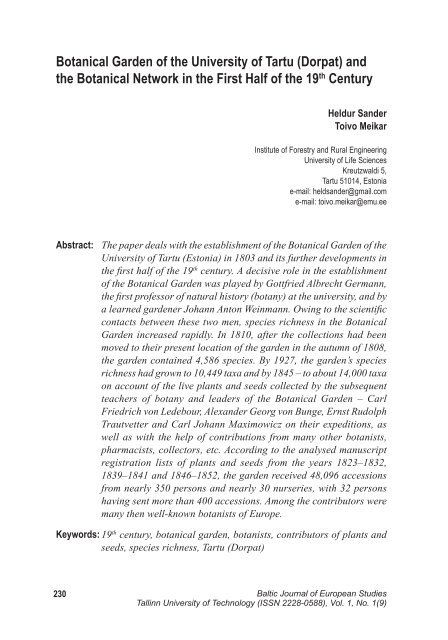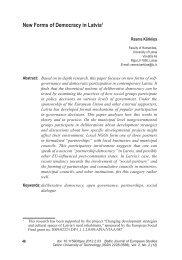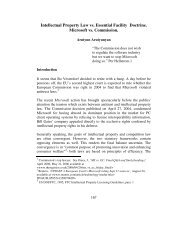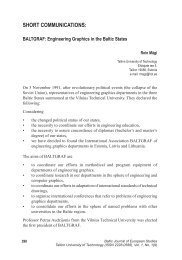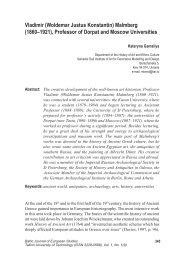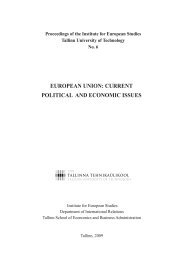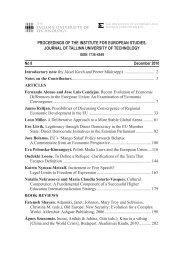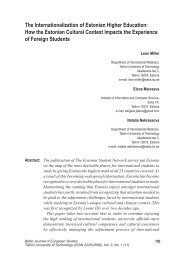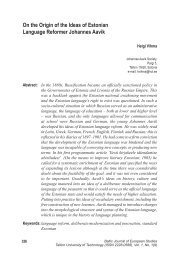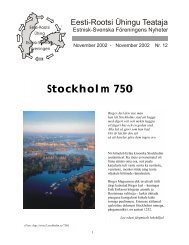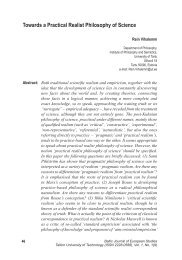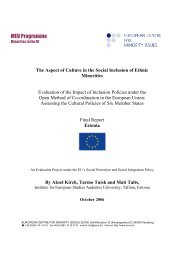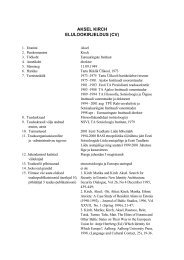Botanical Garden of the university of tartu (dorpat) - The Institute for ...
Botanical Garden of the university of tartu (dorpat) - The Institute for ...
Botanical Garden of the university of tartu (dorpat) - The Institute for ...
Create successful ePaper yourself
Turn your PDF publications into a flip-book with our unique Google optimized e-Paper software.
Heldur Sander, Toivo Meikar<br />
<strong>Botanical</strong> <strong>Garden</strong> <strong>of</strong> <strong>the</strong> University <strong>of</strong> Tartu (Dorpat) and<br />
<strong>the</strong> <strong>Botanical</strong> Network in <strong>the</strong> First Half <strong>of</strong> <strong>the</strong> 19 th Century<br />
Heldur Sander<br />
Toivo Meikar<br />
<strong>Institute</strong> <strong>of</strong> Forestry and Rural Engineering<br />
University <strong>of</strong> Life Sciences<br />
Kreutzwaldi 5,<br />
Tartu 51014, Estonia<br />
e-mail: heldsander@gmail.com<br />
e-mail: toivo.meikar@emu.ee<br />
Abstract: <strong>The</strong> paper deals with <strong>the</strong> establishment <strong>of</strong> <strong>the</strong> <strong>Botanical</strong> <strong>Garden</strong> <strong>of</strong> <strong>the</strong><br />
University <strong>of</strong> Tartu (Estonia) in 1803 and its fur<strong>the</strong>r developments in<br />
<strong>the</strong> first half <strong>of</strong> <strong>the</strong> 19 th century. A decisive role in <strong>the</strong> establishment<br />
<strong>of</strong> <strong>the</strong> <strong>Botanical</strong> <strong>Garden</strong> was played by Gottfried Albrecht Germann,<br />
<strong>the</strong> first pr<strong>of</strong>essor <strong>of</strong> natural history (botany) at <strong>the</strong> <strong>university</strong>, and by<br />
a learned gardener Johann Anton Weinmann. Owing to <strong>the</strong> scientific<br />
contacts between <strong>the</strong>se two men, species richness in <strong>the</strong> <strong>Botanical</strong><br />
<strong>Garden</strong> increased rapidly. In 1810, after <strong>the</strong> collections had been<br />
moved to <strong>the</strong>ir present location <strong>of</strong> <strong>the</strong> garden in <strong>the</strong> autumn <strong>of</strong> 1808,<br />
<strong>the</strong> garden contained 4,586 species. By 1927, <strong>the</strong> garden’s species<br />
richness had grown to 10,449 taxa and by 1845 – to about 14,000 taxa<br />
on account <strong>of</strong> <strong>the</strong> live plants and seeds collected by <strong>the</strong> subsequent<br />
teachers <strong>of</strong> botany and leaders <strong>of</strong> <strong>the</strong> <strong>Botanical</strong> <strong>Garden</strong> – Carl<br />
Friedrich von Ledebour, Alexander Georg von Bunge, Ernst Rudolph<br />
Trautvetter and Carl Johann Maximowicz on <strong>the</strong>ir expeditions, as<br />
well as with <strong>the</strong> help <strong>of</strong> contributions from many o<strong>the</strong>r botanists,<br />
pharmacists, collectors, etc. According to <strong>the</strong> analysed manuscript<br />
registration lists <strong>of</strong> plants and seeds from <strong>the</strong> years 1823–1832,<br />
1839–1841 and 1846–1852, <strong>the</strong> garden received 48,096 accessions<br />
from nearly 350 persons and nearly 30 nurseries, with 32 persons<br />
having sent more than 400 accessions. Among <strong>the</strong> contributors were<br />
many <strong>the</strong>n well-known botanists <strong>of</strong> Europe.<br />
Keywords: 19 th century, botanical garden, botanists, contributors <strong>of</strong> plants and<br />
seeds, species richness, Tartu (Dorpat)<br />
230<br />
Baltic Journal <strong>of</strong> European Studies<br />
Tallinn University <strong>of</strong> Technology (ISSN 2228-0588), Vol. 1, No. 1(9)
<strong>Botanical</strong> <strong>Garden</strong> <strong>of</strong> <strong>the</strong> University <strong>of</strong> Tartu (Dorpat) and<br />
<strong>the</strong> <strong>Botanical</strong> Network in <strong>the</strong> First Half <strong>of</strong> <strong>the</strong> 19 th Century<br />
Introduction<br />
By <strong>the</strong> end <strong>of</strong> <strong>the</strong> 18 th century, a solid botanical network had emerged in Europe,<br />
involving many researchers and amateur naturalists, academic plant taxonomic<br />
research and publishing at universities, numerous extensive expeditions,<br />
botanical gardens, private collections, nurseries and developments in ornamental<br />
gardening. Great numbers <strong>of</strong> plants had been collected in botanical and private<br />
gardens, herbaria had been established, many local and <strong>for</strong>eign floras had been<br />
examined and an extensive botanical bibliography published (Pritzel, 1851, pp.<br />
1–330, 379–391; Meyer, 1857, pp. 254–288; Hill, 1915, pp. 190–223).<br />
<strong>Botanical</strong> science in Russia in <strong>the</strong> 18 th and 19 th century was advanced largely<br />
by natural scientists educated in Germany, France, England, Denmark and<br />
Sweden, who had settled in Russia in <strong>the</strong> 18 th century <strong>for</strong> <strong>the</strong>ir research and <strong>for</strong><br />
arranging research expeditions. At <strong>the</strong> same time, researchers also emerged from<br />
among <strong>the</strong> Baltic Germans. All <strong>the</strong>se researchers published also <strong>the</strong>ir numerous<br />
scientific works in Germany and Russia (Trautvetter, 1837, pp. 4–50, 57–75;<br />
Kolchinsky, 2004, pp. 106–116; Sokol<strong>of</strong>f et al., 2002, pp. 129–191). Thirty-six<br />
better-known botanical gardens with various purposes and names are mentioned<br />
in Russia from <strong>the</strong> 17 th century onward (Trautvetter, 1837, pp. 51–54). Private<br />
gardens were actively established also in <strong>the</strong> provinces <strong>of</strong> Estonia and Livonia,<br />
and also <strong>the</strong> park culture here was highly developed (Hupel, 1791, pp. 534–553;<br />
Germann, 1805, pp. 17–32; Hein, 2007, pp. 15–87).<br />
<strong>The</strong> first private botanical gardens in Russia were established in <strong>the</strong> 18 th century<br />
in <strong>the</strong> manor <strong>of</strong> Demidov near <strong>the</strong> village <strong>of</strong> Krasnoe Solikamsk in <strong>the</strong> Urals<br />
(1731), in <strong>the</strong> Neskuchny Manor <strong>of</strong> Prokopy Demidov in Moscow (1756), and<br />
in <strong>the</strong> manor <strong>of</strong> Alexei Razumovsky at Gorenki (in <strong>the</strong> late 18 th century). In<br />
1771, Ivan Lepekhin registered 422 species in <strong>the</strong> garden <strong>of</strong> Solikamsk, several<br />
<strong>of</strong> <strong>the</strong>m being exotic species. <strong>The</strong> plant catalogue <strong>of</strong> <strong>the</strong> Neskuchny <strong>Garden</strong><br />
contained 2,000 species in 1781 and 4,363 species in 1806. <strong>The</strong> Gorenki <strong>Garden</strong><br />
was led in its early years by botanists Friedrich Christian Stephan (1798–1803),<br />
Ivan Redowsky (1803–1805), and Friedrich Ernst Ludwig von Fischer from<br />
Germany (since 1806), each <strong>of</strong> <strong>the</strong>m giving a contribution to increasing <strong>the</strong><br />
species richness <strong>of</strong> <strong>the</strong> garden. Owing to Fischer, seeds and plants were sent or<br />
brought <strong>the</strong>re by many Russian explorers. In 1803, <strong>the</strong> garden contained 2,846<br />
species, while <strong>the</strong> collection had increased to 8,036 species by 1812 (Trautvetter,<br />
1837, pp. 52–53; Sokol<strong>of</strong>f et al., 2002, pp. 161–169, 182–183; Elina, 2006, pp.<br />
582–583).<br />
Baltic Journal <strong>of</strong> European Studies<br />
Tallinn University <strong>of</strong> Technology (ISSN 2228-0588), Vol. 1, No. 1(9)<br />
231
Heldur Sander, Toivo Meikar<br />
By <strong>the</strong> time <strong>the</strong> <strong>Botanical</strong> <strong>Garden</strong> <strong>of</strong> <strong>the</strong> University <strong>of</strong> Tartu began to be established,<br />
botanical gardens had existed in Europe <strong>for</strong> 250 years and a large variety <strong>of</strong><br />
plants had been introduced <strong>the</strong>re from various regions <strong>of</strong> <strong>the</strong> world. In addition,<br />
good contacts had been established between <strong>the</strong> botanical gardens, botanists<br />
and explorers in Western Europe and Russia. Many researchers who had been<br />
educated in <strong>the</strong> universities <strong>of</strong> Europe had given a great contribution to studying<br />
<strong>the</strong> flora <strong>of</strong> Russia, and many plants were preserved in bigger collections and<br />
herbaria (Trautvetter, 1837, pp. 1–145; Sokol<strong>of</strong>f et al., 2002, pp. 129–191). All<br />
this contributed to <strong>the</strong> rapid <strong>for</strong>mation <strong>of</strong> species richness in <strong>the</strong> <strong>Botanical</strong> <strong>Garden</strong><br />
<strong>of</strong> <strong>the</strong> University <strong>of</strong> Tartu. New plants were obtained from many locations and <strong>the</strong><br />
garden evolved into one <strong>of</strong> <strong>the</strong> biggest and most significant botanical gardens in<br />
Russia in <strong>the</strong> 19 th century, first <strong>of</strong> all due to <strong>the</strong> diversity <strong>of</strong> plants from East Asia.<br />
This paper deals with <strong>the</strong> <strong>for</strong>mation and changes <strong>of</strong> species richness in <strong>the</strong><br />
<strong>Botanical</strong> <strong>Garden</strong> <strong>of</strong> <strong>the</strong> University <strong>of</strong> Tartu in 1804–1851, also providing an<br />
insight into <strong>the</strong> garden’s leading staff as well as <strong>the</strong> provenance and contributors<br />
<strong>of</strong> live plants and seeds in <strong>the</strong> above period.<br />
Methods and material<br />
<strong>The</strong> paper builds on published literature and on manuscripts preserved in <strong>the</strong><br />
Estonian Historical Archives in Tartu (EAA 1) – general plant lists <strong>of</strong>, and data<br />
on contributors <strong>of</strong> plants to, <strong>the</strong> <strong>Botanical</strong> <strong>Garden</strong> <strong>of</strong> <strong>the</strong> University <strong>of</strong> Tartu. <strong>The</strong><br />
general lists cover <strong>the</strong> years 1804, 1816–1818, 1822, 1823–1840, 1842, 1843,<br />
1846, 1848 and 1851. Two general lists are stored in <strong>the</strong> <strong>Botanical</strong> <strong>Garden</strong> <strong>of</strong> <strong>the</strong><br />
University <strong>of</strong> Tartu. One <strong>of</strong> <strong>the</strong>m is untitled and thus it remains unclear which<br />
data it concerns, while <strong>the</strong> o<strong>the</strong>r one is <strong>the</strong> general list <strong>for</strong> 1845 (Enumeratio...,<br />
1845). Both have been analysed be<strong>for</strong>e (Sander, 2010, pp. 90–93). <strong>The</strong> plant<br />
names occurring in <strong>the</strong> manuscripts are written in ink on <strong>the</strong> left-hand pages<br />
toge<strong>the</strong>r with <strong>the</strong> names <strong>of</strong> <strong>the</strong> species’ authors and <strong>of</strong>ten also with <strong>the</strong> names <strong>of</strong><br />
senders <strong>of</strong> <strong>the</strong> plants. In places, plant names in <strong>the</strong> manuscripts have been crossed<br />
out, recorded by numbers or just by <strong>the</strong> names <strong>of</strong> authors, and a few entries have<br />
also been added in between. <strong>The</strong> right-hand pages contain additional data, which<br />
are <strong>of</strong>ten written in pencil and appear to have been added later. <strong>The</strong> lists do not<br />
reveal <strong>the</strong>ir compilers – only in some single cases are <strong>the</strong>y signed and stamped<br />
by <strong>the</strong> <strong>the</strong>n directors <strong>of</strong> <strong>the</strong> garden.<br />
Also <strong>the</strong> registration lists <strong>of</strong> seeds or live plants sent to <strong>the</strong> botanical garden have<br />
been preserved from <strong>the</strong> first half <strong>of</strong> <strong>the</strong> 19 th century. <strong>The</strong>se contain <strong>the</strong> following<br />
232<br />
Baltic Journal <strong>of</strong> European Studies<br />
Tallinn University <strong>of</strong> Technology (ISSN 2228-0588), Vol. 1, No. 1(9)
<strong>Botanical</strong> <strong>Garden</strong> <strong>of</strong> <strong>the</strong> University <strong>of</strong> Tartu (Dorpat) and<br />
<strong>the</strong> <strong>Botanical</strong> Network in <strong>the</strong> First Half <strong>of</strong> <strong>the</strong> 19 th Century<br />
data: <strong>the</strong> name <strong>of</strong> <strong>the</strong> sender, place <strong>of</strong> dispatch, number <strong>of</strong> accessions received on<br />
<strong>the</strong> respective date, and <strong>the</strong> date <strong>of</strong> arrival or registration. <strong>The</strong> names <strong>of</strong> senders are<br />
missing in places. In most cases it is also mentioned whe<strong>the</strong>r <strong>the</strong> parcel contains<br />
seeds or live plants, although <strong>the</strong> latter were sent only in very rare cases. Also <strong>the</strong><br />
names <strong>of</strong> plants are listed. <strong>The</strong> lists cover <strong>the</strong> following periods: 23 Jan 1823–7<br />
Nov 1832, 10 Apr 1839–22 May 1841 and 12 May 1846–1854 (EAA 2).<br />
Leaders <strong>of</strong> <strong>the</strong> <strong>Botanical</strong> <strong>Garden</strong> <strong>of</strong> <strong>the</strong> University <strong>of</strong> Tartu<br />
In <strong>the</strong> first half <strong>of</strong> <strong>the</strong> 19 th century, <strong>the</strong> <strong>Botanical</strong> <strong>Garden</strong> <strong>of</strong> <strong>the</strong> University <strong>of</strong> Tartu<br />
had three directors: Gottfried Albrecht Germann (1803–1809), Carl Friedrich<br />
von Ledebour (1811–1836) and Alexander Georg von Bunge (1836–1867)<br />
(Siilivask, 1982, pp. 185–188). Next to <strong>the</strong> directors, a great contribution to <strong>the</strong><br />
development <strong>of</strong> <strong>the</strong> <strong>Botanical</strong> <strong>Garden</strong> was made by <strong>the</strong> assistant directors and<br />
learned gardeners (Meikar, 2002, pp. 61–73) (Table 1). <strong>The</strong> latter immediately<br />
started to lead <strong>the</strong> work in <strong>the</strong> garden and had a great impact on <strong>the</strong> actual<br />
situation in <strong>the</strong> garden.<br />
Table 1.<br />
Directors and learned gardeners <strong>of</strong> <strong>the</strong> <strong>Botanical</strong> <strong>Garden</strong> <strong>of</strong> <strong>the</strong> University <strong>of</strong><br />
Tartu in <strong>the</strong> first half <strong>of</strong> <strong>the</strong> 19 th century* (Meikar, 2002, p. 65)<br />
Directors Assistant directors Head gardeners<br />
Gottfried Albrecht<br />
Germann<br />
(1803–1809)<br />
Carl Christian<br />
Friedrich<br />
von Ledebour<br />
(1811–1836)<br />
Alexander Georg<br />
von Bunge<br />
(1836–1867)<br />
Ernst Rudolph Trautvetter<br />
(1833–1835)<br />
Carl Albert Rathlef (1835)<br />
Carl Herrmann Bluhm<br />
(1835–1836)<br />
Anton Bärnh<strong>of</strong>f (1836)<br />
Friedrich Julius Seetzen<br />
(1836–1846)<br />
Friedrich Wilhelm Kupffer<br />
(1848–1850)<br />
Carl Johann Maximowicz<br />
(1850–1852)<br />
* <strong>The</strong> table does not include short-term substitutes in <strong>the</strong>se positions.<br />
Johann Friedrich Kieser<br />
(1803–1804)<br />
Johann Peter Buek (1804)<br />
Johann Anton Weinmann<br />
(1805–1813)<br />
Albert Siegmund Natusch<br />
(1813–1814)<br />
Carl Neumark (1814–1816)<br />
Ludwig Riedel (1818–1820)<br />
Louis Autem (1821)<br />
Heinrich Wilhelm Gebhardt<br />
(1825–1832)<br />
Friedrich Wilhelm Günter<br />
(1833–1834)<br />
Wilhelm Eduard Stelling<br />
(1834–1876)<br />
Baltic Journal <strong>of</strong> European Studies<br />
Tallinn University <strong>of</strong> Technology (ISSN 2228-0588), Vol. 1, No. 1(9)<br />
233
Heldur Sander, Toivo Meikar<br />
<strong>The</strong> <strong>Botanical</strong> <strong>Garden</strong> was founded and organised by Pr<strong>of</strong>essor Germann (1773–<br />
1809), <strong>the</strong> first pr<strong>of</strong>essor <strong>of</strong> natural history (botany) at <strong>the</strong> University <strong>of</strong> Tartu,<br />
whose research at <strong>the</strong> <strong>university</strong> focused mostly on botany and ornithology. In<br />
his teaching work, he lectured on Natural History, Botany, Zoology, Mineralogy,<br />
Entomology and Ornithology. Germann also established a cabinet <strong>of</strong> natural<br />
history <strong>for</strong> <strong>the</strong> accommodation <strong>of</strong> various collections and <strong>for</strong> teaching work,<br />
and assembled an entomological and rock collection and a herbarium (Siilivask,<br />
1982, pp. 185–186; Sander et al., 2009, pp. 46–50).<br />
Germann was assisted in establishing <strong>the</strong> <strong>Botanical</strong> <strong>Garden</strong> by learned<br />
gardeners Kieser, Buek and Weinmann (Meikar, 2002, pp. 64–67). In<br />
1805, Johann Anton Weinmann (1782–1858), a practitioner with extensive<br />
horticultural experience from Germany, assumed <strong>the</strong> head gardener’s position<br />
at <strong>the</strong> <strong>Botanical</strong> <strong>Garden</strong> and held <strong>the</strong> position until 1813. Prior to coming to<br />
Tartu, he worked in <strong>the</strong> <strong>Botanical</strong> <strong>Garden</strong> <strong>of</strong> Würzburg and as an assistant to<br />
Razumowski’s 1 palace gardener Rosenthal 2 in Vienna. Weinmann continued<br />
<strong>the</strong> work <strong>of</strong> his predecessors in <strong>the</strong> old location <strong>of</strong> <strong>the</strong> <strong>Botanical</strong> <strong>Garden</strong> and<br />
established <strong>the</strong> garden in its present location in Tartu (Lai 38/40). Planting <strong>of</strong><br />
<strong>the</strong> plants transferred from <strong>the</strong> old garden, as well as new ones, started under<br />
his guidance in <strong>the</strong> autumn <strong>of</strong> 1808 and <strong>the</strong> new garden was mostly completed<br />
by 1810 (Weinmann, 1810, pp. XI–XIII; Le Lièvre, 1997a, pp. 36–38; Sander<br />
& Meikar, 2009, pp. 72–85). In 1813, Weinmann moved to St Petersburg,<br />
where he initially worked in <strong>the</strong> garden <strong>of</strong> <strong>the</strong> Gatchina Palace and two years<br />
later became <strong>the</strong> supervisor <strong>of</strong> <strong>the</strong> gardens <strong>of</strong> Pavlovsk Palace. He was a<br />
flora researcher and taxonomist, with his research involving, next to vascular<br />
plants, also bryophytes, lichens, algae and, in particular, fungi. He was elected<br />
a correspondent member <strong>of</strong> <strong>the</strong> St Petersburg Academy <strong>of</strong> Sciences in 1831<br />
(Siilivask, 1982, p. 186; Lipshits, 1947, pp. 77–78).<br />
After Germann’s death, <strong>the</strong> position <strong>of</strong> pr<strong>of</strong>essor <strong>of</strong> botany remained vacant,<br />
while <strong>the</strong> duties <strong>of</strong> <strong>the</strong> director <strong>of</strong> <strong>the</strong> <strong>Botanical</strong> <strong>Garden</strong> were assumed by<br />
Weinmann (Tänavots, 1994, p. 30). Initially, <strong>the</strong>re were several candidates <strong>for</strong><br />
<strong>the</strong> position <strong>of</strong> pr<strong>of</strong>essor <strong>of</strong> botany, including Karl (Carl) Asmund Rudolphi<br />
(1771–1832), Ledebour’s teacher at <strong>the</strong> University <strong>of</strong> Greifswald, who, however,<br />
withdrew his candidacy. Yet no elections were held <strong>for</strong> some reason. <strong>The</strong> second<br />
1<br />
Count Andrei Razumowski (1752–1836), a Russian diplomat, worked in 1777–1779<br />
in <strong>the</strong> Russian Embassy in Vienna, since 1794 <strong>the</strong> Russian ambassador in Vienna.<br />
Later lived in Italy, returned to Vienna in 1801.<br />
2<br />
Johann Konrad Rosenthal was a <strong>the</strong>n famous gardener in Austria, in particular in<br />
Vienna.<br />
234<br />
Baltic Journal <strong>of</strong> European Studies<br />
Tallinn University <strong>of</strong> Technology (ISSN 2228-0588), Vol. 1, No. 1(9)
<strong>Botanical</strong> <strong>Garden</strong> <strong>of</strong> <strong>the</strong> University <strong>of</strong> Tartu (Dorpat) and<br />
<strong>the</strong> <strong>Botanical</strong> Network in <strong>the</strong> First Half <strong>of</strong> <strong>the</strong> 19 th Century<br />
time, Ledebour and Tauscher 3 were <strong>the</strong> only candidates. Ledebour was preferred<br />
and took up <strong>the</strong> position. Ledebour (1785–1851) entered <strong>the</strong> University <strong>of</strong><br />
Greifswald in 1802 and graduated as a Master <strong>of</strong> Science in 1805, earning also<br />
his Doctor <strong>of</strong> Medicine degree in <strong>the</strong> same year. On his way to Tartu, Ledebour<br />
stopped in Berlin, where he became acquainted with C. L. Wildenow 4 and P. S.<br />
Pallas 5 . Ledebour worked at <strong>the</strong> University <strong>of</strong> Tartu <strong>for</strong> 25 years (1811–1836)<br />
(Levitskii, 1902, pp. 344–348; Tankler & Pullonen, 1994, p. 17).<br />
Ledebour lectured on Botany, but also Pharmacological Botany, Terminology<br />
<strong>of</strong> Botany, History <strong>of</strong> Botany, etc., and, to a small extent, also Zoology and<br />
Mineralogy. He also taught practical courses <strong>for</strong> advanced students and guided<br />
botanical tours (Tankler & Pullonen, 1994, p. 12).<br />
Ledebour also made great ef<strong>for</strong>ts to extend <strong>the</strong> <strong>Botanical</strong> <strong>Garden</strong>. At his<br />
demand, <strong>the</strong> greenhouses and teaching and residential buildings were renovated,<br />
construction <strong>of</strong> <strong>the</strong> wall surrounding <strong>the</strong> garden was completed, and <strong>the</strong> territory<br />
<strong>of</strong> <strong>the</strong> garden was extended on account <strong>of</strong> <strong>the</strong> neighbouring plots. An additional<br />
parcel <strong>of</strong> land was bought in 1822, and <strong>the</strong> area behind <strong>the</strong> pond was filled<br />
and made usable (in parallel with cleaning <strong>of</strong> <strong>the</strong> pond) in 1824. <strong>The</strong> outdoor<br />
planting area tripled as a result <strong>of</strong> various earthworks. <strong>The</strong> budget <strong>of</strong> <strong>the</strong> garden<br />
was increased from 1,200 to 4,000 roubles at his request, and additional 2,000<br />
roubles were allocated to <strong>the</strong> garden in 1829 (Tankler & Pullonen, 1994, p.<br />
18; Tänavots, 1994, p. 30; Poots, 1994, p. 37). Ledebour also replenished <strong>the</strong><br />
equipment <strong>of</strong> <strong>the</strong> Chair <strong>of</strong> Botany, bought state-<strong>of</strong>-<strong>the</strong>-art microscopes and<br />
expanded <strong>the</strong> teaching herbarium and scientific herbarium. <strong>The</strong> plant collections<br />
<strong>of</strong> <strong>the</strong> <strong>Botanical</strong> <strong>Garden</strong> also increased considerably during his time (Siilivask,<br />
1982, p. 186) and <strong>the</strong> seed collection began to be created, amounting to 8,617<br />
specimens in 1837 (Mushinskii, 1911, p. 149).<br />
Ledebour also organised significant expeditions. <strong>The</strong> first one, to <strong>the</strong> Crimea,<br />
was carried out from May to October 1818 toge<strong>the</strong>r with Carl Anton Meyer<br />
(Trautvetter, 1837, p. 38; Tankler & Pullonen, 1994, p. 19). <strong>The</strong> second<br />
expedition, a two-year journey to Altai, was undertaken in 1826–1827 toge<strong>the</strong>r<br />
3<br />
August Michael Tauscher (1771–1841) was a philosopher, botanist and entomologist.<br />
He lived in Russia in 1806–1812, organising scientific expeditions in 1806 and later.<br />
Since 1814 he lived in Saxony and since 1826 in Dresden.<br />
4<br />
Carl Ludwig Wildenow (1765–1812) was a German botanist, pharmacist and plant<br />
taxonomist. He worked as a pr<strong>of</strong>essor <strong>of</strong> natural philosophy and botany at <strong>the</strong> Berlin<br />
Collegium and University <strong>of</strong> Berlin and was <strong>the</strong> director <strong>of</strong> <strong>the</strong> <strong>Botanical</strong> <strong>Garden</strong> <strong>of</strong><br />
Berlin from 1801 until his death.<br />
5<br />
Peter Simon Pallas (1741–1811) was a German zoologist and botanist who worked<br />
in Russia in 1767–1810.<br />
Baltic Journal <strong>of</strong> European Studies<br />
Tallinn University <strong>of</strong> Technology (ISSN 2228-0588), Vol. 1, No. 1(9)<br />
235
Heldur Sander, Toivo Meikar<br />
with Alexander von Bunge and Meyer. Each <strong>of</strong> <strong>the</strong> three took a separate extensive<br />
route (Trautvetter, 1837, pp. 18–21; Poots, 1994, pp. 39–40; Le Lièvre, 1997a,<br />
pp. 52–54).<br />
Toge<strong>the</strong>r with Meyer, Bunge and o<strong>the</strong>r botanists, Ledebour examined <strong>the</strong> plant<br />
material collected by botanists Adelbert Chamisso and Morten Wormskjold and<br />
zoologist Johann Friedrich Eschscholtz during <strong>the</strong>ir participation in <strong>the</strong> round<strong>the</strong>-world<br />
journeys <strong>of</strong> Otto von Kotzebue (1815–1818 and 1823–1826), as well<br />
as <strong>the</strong> material collected by Carl (Karl) Eduard Eichwald during his expedition<br />
to Sou<strong>the</strong>rn Russia in 1825–1826 (which started and ended in Kazan). Ledebour<br />
also examined <strong>the</strong> plant material collected by Finnish zoologist Alexander von<br />
Nordmann and Th. Döllinger in Sou<strong>the</strong>rn Russia in 1836 (Trautvetter, 1837, pp.<br />
6, 30–31; 33). On <strong>the</strong> basis <strong>of</strong> <strong>the</strong> plant material collected by him and o<strong>the</strong>rs on<br />
<strong>the</strong> expeditions, he wrote several works, including a four-volume Flora Altaica<br />
(toge<strong>the</strong>r with Bunge and Meyer, published in 1829–1833), a two-volume<br />
travelogue on Altai (published in 1829 and 1830), and a four-volume Flora<br />
Russica, published in 1842–1853 (Trautvetter, 1837, pp. 19, 61; Siilivask, 1982,<br />
pp. 186–187; Kask, 1994, pp. 22–29; Poots, 1994, p. 41; Le Lièvre, 1997a, pp.<br />
41–52).<br />
Bunge, who was elected as pr<strong>of</strong>essor <strong>of</strong> botany, head <strong>of</strong> <strong>the</strong> Chair <strong>of</strong> Botany and<br />
director <strong>of</strong> <strong>the</strong> <strong>Botanical</strong> <strong>Garden</strong> <strong>of</strong> <strong>the</strong> University <strong>of</strong> Tartu after <strong>the</strong> retirement <strong>of</strong><br />
Ledebour in 1836, studied medicine at <strong>the</strong> University <strong>of</strong> Tartu in 1821–1825 and<br />
obtained his doctorate <strong>of</strong> Medicine in 1825. In 1826, Bunge commenced work<br />
as a physician in Barnaul, Tomsk Governorate, and participated in <strong>the</strong> Altai<br />
expedition <strong>of</strong> Ledebour and Meyer. He worked in <strong>the</strong> expedition area (Barnaul,<br />
Zmeinogorsk, eastern Altai) until 1830. In 1830–1832, he participated in an<br />
expedition to Mongolia and from <strong>the</strong>re to Bejing through <strong>the</strong> Gobi Desert as part<br />
<strong>of</strong> a diplomatic mission. In 1832, Bunge carried out a second expedition to Altai.<br />
In 1833, he was elected as an extraordinary pr<strong>of</strong>essor <strong>of</strong> botany <strong>of</strong> <strong>the</strong> University<br />
<strong>of</strong> Kazan and nominated a correspondent member <strong>of</strong> <strong>the</strong> St Petersburg Academy<br />
<strong>of</strong> Sciences. In 1834 and 1835, Bunge carried out expeditions in Sou<strong>the</strong>rn Russia.<br />
In 1857–1859, he participated in an expedition <strong>of</strong> <strong>the</strong> Russian Geographical<br />
Society to Persia (Iran).<br />
Bunge wrote monographs on many complicated plant genera: Acantholimon<br />
(Plumbaginaceae), Anabasis (Chenopodiaceae), Astragalus (Fabaceae),<br />
Cousinia (Asteraceae), Echinops (Asteraceae), Gentiana (Gentianaceae),<br />
Heliotropium (Boraginaceae), and o<strong>the</strong>rs. He has written papers on <strong>the</strong> flora<br />
<strong>of</strong> Russian steppes, Central Asia, Mongolia, China and Iran. As an excellent<br />
taxonomist, Bunge also examined <strong>the</strong> plant collections <strong>of</strong> Alexander Gustav<br />
236<br />
Baltic Journal <strong>of</strong> European Studies<br />
Tallinn University <strong>of</strong> Technology (ISSN 2228-0588), Vol. 1, No. 1(9)
<strong>Botanical</strong> <strong>Garden</strong> <strong>of</strong> <strong>the</strong> University <strong>of</strong> Tartu (Dorpat) and<br />
<strong>the</strong> <strong>Botanical</strong> Network in <strong>the</strong> First Half <strong>of</strong> <strong>the</strong> 19 th Century<br />
von Schrenk; Alexander <strong>The</strong>odor von Middendorff; Gustav Radde, explorer<br />
<strong>of</strong> <strong>the</strong> Crimea, Caucasus and East Siberia; Alexander Lehmann, explorer <strong>of</strong><br />
Central Asia; Alexander Czekanowski, explorer <strong>of</strong> East Siberia; and o<strong>the</strong>rs.<br />
Bunge organised expeditions (some <strong>of</strong> <strong>the</strong>m toge<strong>the</strong>r with Meyer) to <strong>the</strong> <strong>the</strong>n<br />
Estonian, Livonian and Curonian governorates in 1823–1851 and published a<br />
concise overview <strong>of</strong> <strong>the</strong> flora <strong>of</strong> <strong>the</strong> region in 1853. Bunge also replenished<br />
<strong>the</strong> collections <strong>of</strong> <strong>the</strong> <strong>Botanical</strong> <strong>Garden</strong>. <strong>The</strong> greenhouses <strong>of</strong> <strong>the</strong> garden were<br />
modernised in 1855–1857 at his demand and an additional, fifth greenhouse was<br />
built in 1858 (Trautvetter, 1837, pp. 21, 41, 45; Bunge, 1847, pp. 1–139; 1853,<br />
pp. 1–292; Siilivask, 1982, p. 188; Kaavere, 1978, pp. 517–520; Le Lièvre,<br />
1997a, pp. 52–54; Läänelaid, 2006, pp. 255–272).<br />
Due to his high workload and long-term expeditions, Ledebour was requesting<br />
since 1820 that an additional position be opened <strong>for</strong> an assistant to deal mainly<br />
with <strong>the</strong> <strong>Botanical</strong> <strong>Garden</strong>. <strong>The</strong> position <strong>of</strong> assistant director <strong>of</strong> <strong>the</strong> garden was<br />
allocated in 1833 and assumed in <strong>the</strong> same year by Ledebour’s student Ernst<br />
Rudolf Trautvetter (1809–1889). Trautvetter graduated from <strong>the</strong> University <strong>of</strong><br />
Tartu with a gold medal in 1829 and returned to his city <strong>of</strong> birth Jelgava (Mitau)<br />
until assuming <strong>the</strong> position in Tartu. In addition to per<strong>for</strong>ming <strong>the</strong> duties <strong>of</strong> <strong>the</strong><br />
assistant director, Trautvetter worked since 1834 as a private docent, lecturing<br />
also on <strong>the</strong> local flora (Flora Livonica). After leaving Tartu in 1835, he worked<br />
in 1835–1838 as a junior assistant director in <strong>the</strong> St Petersburg <strong>Botanical</strong> <strong>Garden</strong><br />
under director Friedrich Ernst Ludwig von Fischer and moved to <strong>the</strong> University<br />
<strong>of</strong> Kiev in 1838, becoming a pr<strong>of</strong>essor <strong>of</strong> botany <strong>the</strong>re and establishing <strong>the</strong><br />
<strong>university</strong>’s <strong>Botanical</strong> <strong>Garden</strong> in 1841. He was also a dean at Kiev University<br />
in 1841–1847 and rector in 1847–1859. In 1837, Trautvetter was elected as a<br />
correspondent member <strong>of</strong> <strong>the</strong> St Petersburg Academy <strong>of</strong> Sciences. Retiring in<br />
1864, he returned to work in St Petersburg, became <strong>the</strong> acting director <strong>of</strong> <strong>the</strong><br />
<strong>Botanical</strong> <strong>Garden</strong> and was elected as <strong>the</strong> director in 1866 and 1870. Trautvetter<br />
published his first scientific paper in 1830 and <strong>the</strong> last one in 1888. He stood out<br />
<strong>for</strong> his phytogeographic and floristic works (Trautfetter", 1873, p. 178; Regel,<br />
1889, pp. 661–672; Hasselblatt & Otto, 1889, p. 144; Siilivask, 1982, p. 187).<br />
For <strong>the</strong> entire first half <strong>of</strong> <strong>the</strong> 19 th century, <strong>the</strong> assistant director’s position was<br />
held by alumni <strong>of</strong> <strong>the</strong> University <strong>of</strong> Tartu with different specialisation. Rathlef<br />
(1810–1895), who held <strong>the</strong> position <strong>for</strong> a brief period, studied <strong>the</strong>ology and<br />
philosophy at <strong>the</strong> University <strong>of</strong> Tartu in 1828–1832, continued his studies in<br />
Berlin <strong>for</strong> one year and worked as a private tutor in Tartu in 1833–1835. Later,<br />
in 1854–1858, he worked in Tartu as an extraordinary pr<strong>of</strong>essor <strong>of</strong> history and in<br />
1858–1866 as a full pr<strong>of</strong>essor <strong>of</strong> history. Bluhm (1812–1904) studied medicine<br />
in Tartu in 1831–1836 and also received a degree <strong>of</strong> Doctor <strong>of</strong> Medicine <strong>the</strong>re,<br />
Baltic Journal <strong>of</strong> European Studies<br />
Tallinn University <strong>of</strong> Technology (ISSN 2228-0588), Vol. 1, No. 1(9)<br />
237
Heldur Sander, Toivo Meikar<br />
working as an assistant director <strong>of</strong> <strong>the</strong> <strong>Botanical</strong> <strong>Garden</strong> during ei<strong>the</strong>r his studies<br />
or study breaks. Since 1837, he worked as a practicing physician in Jelgava.<br />
Bärnh<strong>of</strong>f (1812–1855) studied medicine in Tartu in 1831–1835, worked as an<br />
assistant director <strong>of</strong> <strong>the</strong> garden <strong>for</strong> a brief period after his graduation and as a<br />
physician in Alūksne (Marienburg, Latvia) since 1838. Seetzen (1810–1885)<br />
studied medicine in Tartu in 1830–1836, worked as an assistant director <strong>of</strong> <strong>the</strong><br />
<strong>Botanical</strong> <strong>Garden</strong> in 1836–1846 and <strong>the</strong>reafter worked in St Petersburg. Kupffer<br />
studied ma<strong>the</strong>matics in Tartu in 1833–1837 and worked as a private tutor in<br />
Curonia after leaving <strong>the</strong> assistant director’s job in Tartu (Hasselblatt & Otto,<br />
pp. 177, 198, 209, 213, 226; Siilivask, 1982, p. 159). Thus, despite <strong>the</strong> fact that<br />
Ledebour had been requesting <strong>for</strong> years <strong>for</strong> an assistant director’s position to be<br />
allocated, no competent worker who would also be an outstanding researcher<br />
emerged <strong>for</strong> this position after Trautvetter during <strong>the</strong> first half <strong>of</strong> <strong>the</strong> 19 th century.<br />
Ano<strong>the</strong>r assistant director <strong>of</strong> outstanding merit, next to Trautvetter, was Carl<br />
Johann Maximowicz (1827–1892), who graduated from <strong>the</strong> University <strong>of</strong><br />
Tartu in 1850 as a student <strong>of</strong> Bunge. His two-year period in Tartu is regarded<br />
as preparation <strong>for</strong> his subsequent grand works. After leaving Tartu, he moved to<br />
work as herbarium curator in <strong>the</strong> St Petersburg <strong>Botanical</strong> <strong>Garden</strong> (1852–1855,<br />
1858–1859, 1864–1869), where he became <strong>the</strong> head botanist in 1869 and was<br />
elected as <strong>the</strong> temporary director <strong>of</strong> <strong>the</strong> museum and biology laboratory <strong>of</strong> <strong>the</strong><br />
<strong>Botanical</strong> <strong>Garden</strong> in 1870. In 1855–1858 and 1859–1864, Maximowicz worked as<br />
a botanist-explorer. In 1853–1854, he participated in a round-<strong>the</strong>-world expedition<br />
on <strong>the</strong> ship Diana toge<strong>the</strong>r with Leopold von Schrenk and, in 1854–1857, explored<br />
<strong>the</strong> vegetation <strong>of</strong> <strong>the</strong> Amur region. His later expeditions took him to Mongolia,<br />
Tibet, China, Korea and Japan (Trautfetter", 1873, pp. 181–182; Siilivask, 1982,<br />
p. 188; Le Lièvre, 1997b, pp. 131–143; Barnes, 2001, p. 3).<br />
Learned gardeners are known to have changed frequently during Ledebour’s<br />
time. On some occasions <strong>the</strong>re were none working at <strong>the</strong> garden and Ledebour<br />
himself had to do <strong>the</strong> work. <strong>The</strong> only noteworthy learned gardener at this time<br />
was Gebhardt from Riga, who worked in this position <strong>for</strong> a longer period than<br />
<strong>the</strong> o<strong>the</strong>rs (Willkomm, 1873, p. 23). Un<strong>for</strong>tunately, he died in 1832 at <strong>the</strong> age<br />
<strong>of</strong> 29. Gebhardt may have been dealing with <strong>the</strong> plants and herbaria brought<br />
along by Ledebour from his journeys (Le Lièvre, 1997a, p. 40). Gebhardt was<br />
succeeded in <strong>the</strong> position <strong>of</strong> learned gardener by Wilhelm Eduard Stelling, who<br />
started in 1828 as a gardener’s apprentice and later worked as assistant to <strong>the</strong><br />
learned gardener. <strong>The</strong> administration was satisfied in all respects with his work<br />
and he was repeatedly acknowledged <strong>for</strong> <strong>the</strong> excellent order attained in <strong>the</strong><br />
garden (Meikar, 2002, p. 67).<br />
238<br />
Baltic Journal <strong>of</strong> European Studies<br />
Tallinn University <strong>of</strong> Technology (ISSN 2228-0588), Vol. 1, No. 1(9)
<strong>Botanical</strong> <strong>Garden</strong> <strong>of</strong> <strong>the</strong> University <strong>of</strong> Tartu (Dorpat) and<br />
<strong>the</strong> <strong>Botanical</strong> Network in <strong>the</strong> First Half <strong>of</strong> <strong>the</strong> 19 th Century<br />
Species richness in <strong>the</strong> <strong>Botanical</strong> <strong>Garden</strong> in 1810–1851<br />
According to literature data based on Weinmann’s list from 1810, <strong>the</strong>re were 4,360<br />
plant species growing in <strong>the</strong> garden in 1810, with 509 <strong>of</strong> <strong>the</strong>m being native plants<br />
(Siilivask, 1982, p. 186). <strong>The</strong> list contained 4,586 species from 968 genera. <strong>The</strong><br />
mode <strong>of</strong> cultivation was not specified <strong>for</strong> two <strong>of</strong> <strong>the</strong>m. Of <strong>the</strong> remaining 4,584<br />
taxa, 742 were growing in a heated greenhouse, 1,508 were growing in a cold<br />
greenhouse, and 2,358 – in <strong>the</strong> open ground. This makes a total <strong>of</strong> 4,608 taxa,<br />
<strong>of</strong> which 24 occurred in two sites, mostly both in a cold greenhouse and in <strong>the</strong><br />
open ground (Weinmann, 1810, pp. 1–170; Sander & Meikar, 2009, p. 82). After<br />
1810, <strong>the</strong> number <strong>of</strong> plant species in <strong>the</strong> garden increased, although <strong>the</strong> increase<br />
was not continuous but variable between years. In 1827, <strong>the</strong> garden had 10,449<br />
species (Ewers, 1827, p. 439), and no o<strong>the</strong>r numerical data are known to have been<br />
recorded <strong>for</strong> that year. Of <strong>the</strong> 10,449 species, 4,477 were growing in greenhouses<br />
and 7,627 were growing in <strong>the</strong> open ground. As we can see, <strong>the</strong>re were more<br />
plants growing in <strong>the</strong> garden in total than recorded on <strong>the</strong> species list. Thus, 1,655<br />
species were growing both in greenhouses and in <strong>the</strong> open ground. <strong>The</strong> biggest<br />
plant genera were Allium (with 90 species), followed by Astragalus and Rosa (both<br />
with 76 species), Potentilla (65), Campanula and Euphorbia (both 56), Medicago<br />
(54) and Iris (52). <strong>The</strong> collection also included over 800 Siberian species brought<br />
by Ledebour from his 1826 expedition, some <strong>of</strong> which were completely new to<br />
science and some had not been brought into cultivation earlier. <strong>The</strong> <strong>Botanical</strong><br />
<strong>Garden</strong> also had a herbarium <strong>of</strong> Altaian flora with 1,600 species.<br />
All registered plant names were counted separately from <strong>the</strong> volumes <strong>of</strong> 1845<br />
and 1851. In 1845, <strong>the</strong> left-hand pages contained 13,665 species from 1,707<br />
genera, with more than 1,500 taxa being woody plants (Enumeratio…, 1845).<br />
<strong>The</strong> genera Alnus, Betula and Carpinus appeared on torn-out pages. Part <strong>of</strong><br />
<strong>the</strong> 13,665 taxa have been crossed out later and ra<strong>the</strong>r many are unidentified<br />
and recorded with numbers. Considering <strong>the</strong> fact that eight pages had been<br />
torn out (with an average <strong>of</strong> 35 taxa per page) and three were partly torn out,<br />
<strong>the</strong> list may have included approximately 14,000 taxa. In places, plants have<br />
been recorded also on right-hand pages – <strong>the</strong>se are pencil-written and appear<br />
to have been added later. A total <strong>of</strong> 438 additional taxa from 81 genera were<br />
listed on such pages, 87 <strong>of</strong> <strong>the</strong>m being woody plants (Enumeratio..., 1845). <strong>The</strong><br />
most extensively represented genera were Silene (190 taxa), Hieracium (160),<br />
Veronica (148), Centaurea (131), Rosa (128, <strong>of</strong> which 40 were unidentified),<br />
Potentilla (116), Thalictrum (104) and Salvia (100 taxa), followed by Dianthus,<br />
Iris, Triticum and Vicia (each with 94 taxa). Of woody plants, <strong>the</strong> genus Rosa<br />
was represented with 166 supposed taxa, <strong>of</strong> which 13 were recorded just by<br />
Baltic Journal <strong>of</strong> European Studies<br />
Tallinn University <strong>of</strong> Technology (ISSN 2228-0588), Vol. 1, No. 1(9)<br />
239
Heldur Sander, Toivo Meikar<br />
<strong>the</strong> author’s name and 27 were recorded with numbers. <strong>The</strong> genus Rosa was<br />
followed by Ribes (42 taxa); Pyrus, incl. Malus, (39); Crataegus (31); Pinus<br />
(incl. Abies, Larix, Picea), Erica and Cytisus (27); Lonicera (25); Acer (20);<br />
Caragana (19); Rhamnus (18); and Rhododendron and Cotoneaster (14).<br />
By 1851, <strong>the</strong> species richness <strong>of</strong> <strong>the</strong> garden had not decreased – <strong>the</strong> list contained<br />
13,180 taxa from 1,886 genera (EAA 1). <strong>The</strong> most extensively represented<br />
genera were Silene (196 taxa), Hieracium (158), Potentilla (152), Veronica<br />
(123), Centaurea (115), Iris (114), Thalictrum (110), Allium (109), Astragalus<br />
(95) and Salvia (90). <strong>The</strong> biggest genus <strong>of</strong> woody plants was Rosa (90 taxa),<br />
followed by Crataegus (38), Spiraea (35), Lonicera (31), Fraxinus and Berberis<br />
(25) and Acer (22). Also <strong>the</strong> genus Clematis, which includes both herbaceous<br />
and woody plants, was numerously represented – with 45 taxa.<br />
Contributors <strong>of</strong> live plants and seeds in 1823–1854<br />
General data<br />
In <strong>the</strong> period covered in this paper, <strong>the</strong> <strong>Botanical</strong> <strong>Garden</strong> received 48,096<br />
accessions <strong>of</strong> live plants and seeds. In eight years <strong>the</strong> number <strong>of</strong> accessions<br />
amounted to more than three thousand. <strong>The</strong> largest number <strong>of</strong> accessions (nearly<br />
4,000) was received in 1840. <strong>The</strong> figure <strong>for</strong> 1839 refers to accessions received in<br />
April and <strong>the</strong> one <strong>for</strong> 1846 refers to <strong>the</strong> ones received in May (Table 2).<br />
<strong>The</strong> senders <strong>of</strong> live plants and seeds to <strong>the</strong> <strong>Botanical</strong> <strong>Garden</strong> are referenced<br />
in <strong>the</strong> manuscripts by <strong>the</strong>ir names and places <strong>of</strong> dispatch. <strong>The</strong> title ‘pr<strong>of</strong>essor’<br />
(pr<strong>of</strong>.) and <strong>the</strong> initials are sometimes added, and <strong>the</strong> first name is added in very<br />
rare cases. <strong>The</strong> authors are <strong>of</strong> <strong>the</strong> opinion that <strong>the</strong> persons referred to in this<br />
paper are likely to have been <strong>the</strong> senders. Data on <strong>the</strong> persons were obtained<br />
from various encyclopaedic publications, websites <strong>of</strong> universities, various<br />
overviews (Trautvetter, 1837, pp. 137–145; Pontt & Döhren, 1845; Pritzel,<br />
1851; Meyer, 1857; Trautfetter", 1873; Hasselblatt & Otto, 1889; Levitskii,<br />
1902/1903; Lipshits, 1947–1952; Bugyi, 1965; Rowell, 1980; Morton, 1981;<br />
Siilivask, 1982; Minelli, 1988; Barthlott, 1990; Peterson, 1996, pp. 77–80;<br />
Doctor, 2001; Kongo, 2003; Bumblauskas et al., 2004, pp. 29–39; Zdenek &<br />
Zalewska-Galosz, 2004, pp. 1033–1034; Ričkienė, 2009, pp. 168–169; Franz<br />
Paula von Schrank 2011; Index Collectorum, 2011; Italian botanists, 2011).<br />
Contributions were received from a total <strong>of</strong> nearly 180 persons and nearly 10<br />
nurseries, with 32 persons having sent more than 400 accessions and 12 persons<br />
240<br />
Baltic Journal <strong>of</strong> European Studies<br />
Tallinn University <strong>of</strong> Technology (ISSN 2228-0588), Vol. 1, No. 1(9)
<strong>Botanical</strong> <strong>Garden</strong> <strong>of</strong> <strong>the</strong> University <strong>of</strong> Tartu (Dorpat) and<br />
<strong>the</strong> <strong>Botanical</strong> Network in <strong>the</strong> First Half <strong>of</strong> <strong>the</strong> 19 th Century<br />
– over 1,000 accessions (Table 3). A total <strong>of</strong> 35,708 accessions (74%) were<br />
received from <strong>the</strong> 32 persons.<br />
In addition to <strong>the</strong> 32 persons listed in <strong>the</strong> table, 301–400 accessions were<br />
received from five persons: Martin Martens (1797–1863), pr<strong>of</strong>essor <strong>of</strong><br />
chemistry and botany at <strong>the</strong> Louvain Catholic University, sent 357 accessions<br />
from Louvain; apo<strong>the</strong>cary Williams – 357 from Tbilisi; botanist and agronomist<br />
Joseph Decaisne (1807–1882) – 378 from Paris; botanist Jean Baptiste Verlot<br />
(1825–1891) – 365 from Grenoble; and Ernst Rudolph Trautvetter – 370 from<br />
Kiev. 200–300 accessions were received from 18 persons.<br />
Table 2.<br />
Accessions received by <strong>the</strong> <strong>Botanical</strong> <strong>Garden</strong> in different years<br />
Year<br />
No. <strong>of</strong><br />
accessions<br />
Year<br />
No. <strong>of</strong><br />
accessions<br />
Year<br />
No. <strong>of</strong><br />
accessions<br />
Year<br />
No. <strong>of</strong><br />
accessions<br />
Year<br />
No. <strong>of</strong><br />
accessions<br />
1823 2,534 1824 3,031 1825 3,227 1826 3,230 1827 2,019<br />
1828 1,909 1829 3,578 1830 3,546 1831 3,452 1832 3,685<br />
1839 726 1840 3,965 1841 2,835 1846 368 1847 1,250<br />
1848 1,116 1849 766 1850 629 1851 2,395 1852 1,054<br />
1853 1,774 1854 1,007 Total<br />
48,096<br />
Table 3.<br />
Major contributors <strong>of</strong> accessions to <strong>the</strong> <strong>Botanical</strong> <strong>Garden</strong> <strong>of</strong> <strong>the</strong> University <strong>of</strong><br />
Tartu<br />
Senders and<br />
places <strong>of</strong> dispatch<br />
Carl Anton Meyer,<br />
St Petersburg,<br />
Caucasus, Baku,<br />
Kazbek, Balastan<br />
(Iran)<br />
Johann Jakob<br />
Bernhardi, Erfurt<br />
Jens Wilken<br />
Hornemann,<br />
Copenhagen<br />
Christoph Friedrich<br />
Otto, Berlin<br />
Years <strong>of</strong><br />
sending<br />
1828–1831<br />
1850–1854<br />
1823–1832<br />
1840, 1841<br />
1846, 1847<br />
No. <strong>of</strong><br />
accessions<br />
Senders and places <strong>of</strong><br />
dispatch<br />
2,908 Gustav Schübler,<br />
Tübingen<br />
2,417 F. Hunneman,<br />
London, Mexico, South<br />
America, Chile<br />
Years <strong>of</strong><br />
sending<br />
No. <strong>of</strong><br />
accessions<br />
1825–1832 790<br />
1830, 1831<br />
1832<br />
1823–1825 2,314 Gustav Kunze, Leipzig 1840, 1841<br />
1847–1851<br />
1823–1832<br />
1840, 1841<br />
2,232 Friedrich Georg Gottlieb<br />
Bartling, Göttingen<br />
1841,<br />
1846–1848<br />
1850, 1852<br />
1853<br />
767<br />
747<br />
743<br />
Baltic Journal <strong>of</strong> European Studies<br />
Tallinn University <strong>of</strong> Technology (ISSN 2228-0588), Vol. 1, No. 1(9)<br />
241
Heldur Sander, Toivo Meikar<br />
Senders and<br />
places <strong>of</strong> dispatch<br />
Friedrich Ernst<br />
Ludwig Fischer, St<br />
Petersburg<br />
Heinrich Gottlieb<br />
Ludwig Reichenbach<br />
or his son Heinrich<br />
Gustav Reichenbach,<br />
Dresden<br />
Heinrich Adolf<br />
Schrader, Göttingen<br />
Carl Friedrich von<br />
Ledebour, Kazan,<br />
Tomsk, Barnaul<br />
Charles-François<br />
Brisseau de Mirbel,<br />
Paris<br />
Johann Georg<br />
Christian Lehmann,<br />
Hamburg<br />
Carl Constantin<br />
Christian Haberle,<br />
Pest<br />
Ludolph Christian<br />
Treviranus, Wroclaw,<br />
Prague, Bonn<br />
Alojzy Rafal<br />
Estreicher,<br />
Krakow<br />
Jósef Jundziłł,<br />
Vilnius<br />
Vincenz Frantisek<br />
Kosteletzky, Prague<br />
Christian Friedrich<br />
Hornschuch,<br />
Greifswald<br />
Years <strong>of</strong><br />
sending<br />
1825–1832<br />
1840, 1841<br />
1846<br />
1823–1825<br />
1827, 1828<br />
1830, 1832<br />
1839, 1840<br />
1848–1852<br />
No. <strong>of</strong><br />
accessions<br />
Senders and places <strong>of</strong><br />
dispatch<br />
2,059 Curt Polycarp Joachim<br />
Sprengel, Halle<br />
1,761 Michał Szubert,<br />
Warsaw<br />
1823–1832 1,659 Wilibald Swibert Joseph<br />
Gottlieb von Besser,<br />
Krzemeniec<br />
Years <strong>of</strong><br />
sending<br />
1823–1825<br />
1828–1832<br />
1823–1828<br />
1830, 1832<br />
1840, 1841<br />
1823–1825<br />
1827, 1828<br />
1830, 1832<br />
1826 1,498 Ernst Meyer, Königsberg 1828–1832<br />
1840, 1841<br />
1847–1851<br />
1829–1832<br />
1841, 1847<br />
1848<br />
1823–1826<br />
1828–1832<br />
1840, 1841<br />
1847–1854<br />
1823–1830<br />
1832<br />
1,431 Bartels, Kharkov 1823–1825<br />
1828–1830<br />
1,369 Georg Matthias von<br />
Martens, Munich, Trieste,<br />
Christiania (Oslo)<br />
1,260 Frederic von Gebler,<br />
Barnaul<br />
1823–1832 1,046 Johann Anton Weinmann,<br />
Pavlovsk, St Petersburg<br />
1824, 1826<br />
1829–1831<br />
1840, 1841<br />
995 Friedrich Sigmund Voigt,<br />
Jena<br />
1824–1829 829 Eduard August von Regel,<br />
Zürich<br />
1831, 1832<br />
1840, 1841<br />
1847, 1851<br />
1853, 1854<br />
1823–1825<br />
1828,<br />
1830–1832<br />
1847, 1850<br />
1851<br />
809 Michele Tenore,<br />
Navre?<br />
807 Vassili Matveevich<br />
Tschernajew? (Czernajew)<br />
1827,<br />
1830–1832<br />
1823–1828<br />
1839<br />
No. <strong>of</strong><br />
accessions<br />
740<br />
731<br />
678<br />
637<br />
621<br />
618<br />
615<br />
1824, 1825 598<br />
1828–1830<br />
1840, 1853<br />
1823–1825 526<br />
1827,<br />
1830–1832<br />
1841<br />
1847–1849<br />
1851<br />
1847–1852 513<br />
1854<br />
1840 508<br />
1840 481<br />
242<br />
Baltic Journal <strong>of</strong> European Studies<br />
Tallinn University <strong>of</strong> Technology (ISSN 2228-0588), Vol. 1, No. 1(9)
Major contributors <strong>of</strong> live plants or seeds<br />
<strong>Botanical</strong> <strong>Garden</strong> <strong>of</strong> <strong>the</strong> University <strong>of</strong> Tartu (Dorpat) and<br />
<strong>the</strong> <strong>Botanical</strong> Network in <strong>the</strong> First Half <strong>of</strong> <strong>the</strong> 19 th Century<br />
<strong>The</strong> biggest amount <strong>of</strong> live plants and seeds was contributed by Carl Anton<br />
Meyer (1795–1855, St Petersburg), who sent 2,908 accessions in <strong>the</strong> years<br />
1828–1831 and 1850–1854 (Table 3). He was born in Vitebsk, studied pharmacy<br />
at <strong>the</strong> University <strong>of</strong> Tartu in 1813–1814 and continued his studies at <strong>the</strong><br />
University <strong>of</strong> Königsberg, where he earned his doctorate in Philosophy in 1825.<br />
Meyer carried out several botanical expeditions in Russia and authored scientific<br />
works both on his own and toge<strong>the</strong>r with August Gustav Heinrich von Bongard,<br />
Bunge, Ledebour, Trautvetter and Fischer from St Petersburg. He examined <strong>the</strong><br />
vascular plant collections <strong>of</strong> several researchers, wrote treatments <strong>of</strong> <strong>the</strong> flora<br />
<strong>of</strong> <strong>the</strong> Vyatka area and <strong>of</strong> various plant genera, and described numerous new<br />
plants. Meyer was <strong>the</strong> assistant director <strong>of</strong> <strong>the</strong> St Petersburg <strong>Botanical</strong> <strong>Garden</strong><br />
in 1831–1851, <strong>the</strong> director in 1851–1855 and full member <strong>of</strong> <strong>the</strong> St. Petersburg<br />
Academy <strong>of</strong> Sciences since 1845. In 1850–1855, Meyer also supervised <strong>the</strong><br />
collections <strong>of</strong> <strong>the</strong> botanical garden (Trautvetter, 1837; pp. 19, 31–33, 28, 45, 61,<br />
64, 88–90, 96, 122, 134; Trautfetter", 1873, pp. 158, 177–178, 211; Hasselblatt<br />
& Otto, 1889, p. 60).<br />
<strong>The</strong> second most active contributor after Meyer was Bernhardi (also pr<strong>of</strong>.<br />
Bernhardi) from Erfurt. <strong>The</strong> name ‘<strong>The</strong>od. Bernhardi’, also from Erfurt, is also<br />
referenced in one case. <strong>The</strong> <strong>for</strong>mer is likely to be <strong>the</strong> above-mentioned Johann<br />
Jakob Bernhardi and <strong>the</strong> latter – <strong>The</strong>odor Bernhardi (who sent 11 accessions<br />
in 1850). Three parcels were received from Erfurt in 1846 from a gardener and<br />
botanist Friedrich Adolph Haage (1796–1866), member <strong>of</strong> a famous family <strong>of</strong><br />
ten generations <strong>of</strong> gardeners. He was <strong>the</strong> founder <strong>of</strong> a small cacti and succulent<br />
trade and seed gardening company in 1822.<br />
From his first journey to <strong>the</strong> Crimea, from May to October 1818, Ledebour<br />
brought approximately 200 plants to <strong>the</strong> <strong>Botanical</strong> <strong>Garden</strong> (Tankler & Pullonen,<br />
1994, p. 19). Ledebour also sent <strong>for</strong>ty-two parcels with live plants and seeds<br />
by mail from <strong>the</strong> Altai expedition carried out in 1826–1827 toge<strong>the</strong>r with<br />
Bunge and physician and botanist Meyer, with 500 <strong>of</strong> <strong>the</strong> species being new<br />
to <strong>the</strong> <strong>Botanical</strong> <strong>Garden</strong>. <strong>The</strong> botanical collection contained 1,600 species on<br />
herbarium sheets, 241 species <strong>of</strong> live plants <strong>for</strong> <strong>the</strong> <strong>Botanical</strong> <strong>Garden</strong> <strong>of</strong> Tartu,<br />
and seeds <strong>of</strong> 1,341 species (Poots, 1994, pp. 39–40). Ano<strong>the</strong>r source (Tänavots,<br />
1994, p. 33) refers to <strong>the</strong> seed registration list, according to which 1,404 species<br />
were brought along both as live plants and as seeds. <strong>The</strong> material was collected<br />
from several locations and some species were <strong>the</strong>re<strong>for</strong>e repeated (Tänavots,<br />
1994, p. 32). According to <strong>the</strong> registration list <strong>of</strong> plants and seeds, Ledebour<br />
sent 1,498 accessions in 1826.<br />
Baltic Journal <strong>of</strong> European Studies<br />
Tallinn University <strong>of</strong> Technology (ISSN 2228-0588), Vol. 1, No. 1(9)<br />
243
Heldur Sander, Toivo Meikar<br />
Contributions were received from St Petersburg from Friedrich Ernst Ludwig<br />
von Fischer (1782–1854), <strong>the</strong> director <strong>of</strong> <strong>the</strong> botanical garden <strong>of</strong> Gorenki<br />
(1806–1822), compiler <strong>of</strong> plant catalogues (1805, 1808, 1812) and later director<br />
<strong>of</strong> <strong>the</strong> St Petersburg <strong>Botanical</strong> <strong>Garden</strong> (1823–1850); and from Stanisław<br />
Boniface Jundziłł (1761–1847), pr<strong>of</strong>essor and director <strong>of</strong> <strong>the</strong> <strong>Botanical</strong> <strong>Garden</strong><br />
<strong>of</strong> <strong>the</strong> University <strong>of</strong> Vilnius. Next to Jundziłł, contributions were sent from<br />
Vilnius by Stanislaw Batys Górski (1802–1864), a student and successor <strong>of</strong><br />
pr<strong>of</strong>essor <strong>of</strong> pharmacy (1810–1831) Jan Fryderyk Wolfgang (Johann Friedrich<br />
Wolfgang; 1775–1859) at <strong>the</strong> Vilnius University. Górski was a Polish botanist,<br />
entomologist, physician and pharmacist, head <strong>of</strong> <strong>the</strong> <strong>Botanical</strong> <strong>Garden</strong> <strong>of</strong> <strong>the</strong><br />
University <strong>of</strong> Vilnius. After <strong>the</strong> closure <strong>of</strong> <strong>the</strong> University <strong>of</strong> Vilnius in 1832 by<br />
special decree <strong>of</strong> Czar Nicholas I (Venclova, 1981, p. 38), plants <strong>of</strong> 261 species<br />
were obtained from its botanical garden in 1841.<br />
Of <strong>the</strong> better-known researchers, contributions were sent by Karl Konstantin<br />
Christian Haberle (1764–1832), naturalist and meteorologist, teacher <strong>of</strong><br />
botany at <strong>the</strong> University <strong>of</strong> Pest; Jens Wilken Hornemann (1770–1841),<br />
Danish botanist, pr<strong>of</strong>essor <strong>of</strong> botany at <strong>the</strong> University <strong>of</strong> Copenhagen since<br />
1808 and director <strong>of</strong> <strong>the</strong> <strong>Botanical</strong> <strong>Garden</strong> since 1817; Johann Georg Christian<br />
Lehmann (1792–1860), a botanist, pr<strong>of</strong>essor <strong>of</strong> physics and natural sciences<br />
and head librarian at <strong>the</strong> Gymnasium Academicum in Hamburg, <strong>the</strong> founder<br />
<strong>of</strong> <strong>the</strong> Hamburg <strong>Botanical</strong> <strong>Garden</strong>; Christoph Friedrich Otto (1783–1856), a<br />
German gardener and botanist, supervisor <strong>of</strong> <strong>the</strong> Berlin <strong>Botanical</strong> <strong>Garden</strong> from<br />
1805 to 1843; Heinrich Adolf Schrader (1767–1836), pr<strong>of</strong>essor and director<br />
<strong>of</strong> <strong>the</strong> <strong>Botanical</strong> <strong>Garden</strong> <strong>of</strong> <strong>the</strong> University <strong>of</strong> Göttingen; Kurt Sprengel (1766–<br />
1833), pr<strong>of</strong>essor and director <strong>of</strong> <strong>the</strong> <strong>Botanical</strong> <strong>Garden</strong> <strong>of</strong> <strong>the</strong> University <strong>of</strong> Halle;<br />
Heinrich Gottlieb Ludwig Reichenbach (1793–1879), a naturalist, zoologist<br />
and botanist, pr<strong>of</strong>essor at <strong>the</strong> Surgical-Medical Academy <strong>of</strong> Dresden, founder <strong>of</strong><br />
<strong>the</strong> Dresden <strong>Botanical</strong> <strong>Garden</strong>s; and Friedrich Siegmund Voight (1781–1850),<br />
a palaeontologist and botanist, pr<strong>of</strong>essor <strong>of</strong> medicine and botany and director<br />
<strong>of</strong> <strong>the</strong> <strong>Botanical</strong> <strong>Garden</strong> <strong>of</strong> Jena University.<br />
Many accessions were sent also by Ernst Heinrich Friedrich Meyer (1791–<br />
1858), pr<strong>of</strong>essor <strong>of</strong> botany and director <strong>of</strong> <strong>the</strong> <strong>Botanical</strong> <strong>Garden</strong> <strong>of</strong> <strong>the</strong> University<br />
<strong>of</strong> Königsberg, and by <strong>the</strong> Czech botanist Vincenc Frantisek Kosteletzky<br />
(1801–1887), who taught Medical Botany at <strong>the</strong> famous botanical research school<br />
in Prague. Among <strong>the</strong> contributors were also Gustav Schübler (1787–1834),<br />
German naturalist, pr<strong>of</strong>essor <strong>of</strong> botany, natural history and agricultural chemistry<br />
and founder <strong>of</strong> applied meteorology in Germany, and by his colleague Georg<br />
Matthias Martens (1788–1872), member <strong>of</strong> <strong>the</strong> German Academy <strong>of</strong> Sciences<br />
Leopoldina since 1832. Schübler and Martens worked toge<strong>the</strong>r in describing and<br />
244<br />
Baltic Journal <strong>of</strong> European Studies<br />
Tallinn University <strong>of</strong> Technology (ISSN 2228-0588), Vol. 1, No. 1(9)
<strong>Botanical</strong> <strong>Garden</strong> <strong>of</strong> <strong>the</strong> University <strong>of</strong> Tartu (Dorpat) and<br />
<strong>the</strong> <strong>Botanical</strong> Network in <strong>the</strong> First Half <strong>of</strong> <strong>the</strong> 19 th Century<br />
classifying new species. O<strong>the</strong>r contributors included Friedrich Gottlieb Bartling<br />
(1798–1875), German botanist, researcher <strong>of</strong> Hungarian and Croatian flora, lecturer<br />
at <strong>the</strong> University <strong>of</strong> Göttingen since 1822 and director <strong>of</strong> <strong>the</strong> botanical garden<br />
since 1837; Frederic Gebler (1781–1850), alumnus <strong>of</strong> <strong>the</strong> medical faculty <strong>of</strong> <strong>the</strong><br />
University <strong>of</strong> Jena (1802), who worked in Russia since 1808, being a physician<br />
at Barnaul since 1810 and also a naturalist, explorer and founder <strong>of</strong> <strong>the</strong> Barnaul<br />
Museum; Wilibald Swibert Joseph Gottlieb Besser (1784–1842), botanist, plant<br />
taxonomist, gardener and founder <strong>of</strong> <strong>the</strong> Kremenets (Krzemieniec) <strong>Botanical</strong><br />
<strong>Garden</strong>; Vassili Matveevich Tschernajew (Czernajew) (1796–1871), pr<strong>of</strong>essor<br />
<strong>of</strong> botany at <strong>the</strong> University <strong>of</strong> Kharkov and <strong>the</strong> director <strong>of</strong> <strong>the</strong> <strong>Botanical</strong> <strong>Garden</strong>;<br />
and Bartels from Kharkov. Overviews <strong>of</strong> Russian botanical science and botanists<br />
(Trautvetter, 1837, pp. 137–145; Borodin, 1908, pp. 1–158) do not refer to Bartels.<br />
In 1853, nine deliveries arrived from Jena from Mattias Jacob Schleiden<br />
(1804–1881), student <strong>of</strong> Bartling at <strong>the</strong> University <strong>of</strong> Göttingen. He initially<br />
studied law at <strong>the</strong> University <strong>of</strong> Heidelberg and received a degree <strong>of</strong> Doctor <strong>of</strong><br />
Medicine <strong>the</strong>re. In 1832, he began to study medicine in Göttingen, where he<br />
became interested in natural sciences, in particular botany. In 1839, Schleiden<br />
became a Doctor <strong>of</strong> Philosophy and extraordinary pr<strong>of</strong>essor at <strong>the</strong> University <strong>of</strong><br />
Jena, becoming a full pr<strong>of</strong>essor and director <strong>of</strong> <strong>the</strong> botanical garden in 1850. He<br />
was one <strong>of</strong> <strong>the</strong> founders <strong>of</strong> <strong>the</strong> cell <strong>the</strong>ory toge<strong>the</strong>r with <strong>The</strong>odor Schwamm. In<br />
1863, Schleiden became <strong>the</strong> first teacher <strong>of</strong> plant physiology at <strong>the</strong> University<br />
<strong>of</strong> Tartu, from where he returned to Dresden in 1864 due to misunderstandings<br />
with <strong>the</strong> <strong>university</strong> (Moorits, 1968, pp. 138–151; Siilivask, 1985, pp. 93–94).<br />
Polish botanist and entomologist Alojzy Rafal Estreicher (1786–1852) studied<br />
at <strong>the</strong> Jagiellonian University in Krakow, earning his doctorate in Medicine<br />
<strong>the</strong>re in 1807 and doctorate in Philosophy in 1811. Since 1809, he led <strong>the</strong> Chair<br />
<strong>of</strong> Botany and Zoology at <strong>the</strong> same <strong>university</strong> and worked at <strong>the</strong> <strong>university</strong> as a<br />
pr<strong>of</strong>essor, rector (1831–1833) and <strong>the</strong> first director <strong>of</strong> <strong>the</strong> botanical garden. He<br />
sent 995 accessions.<br />
Ludolph Christian Treviranus (1779–1864) sent 1,046 accessions from<br />
Wrocław, Prague and Bonn. He was a German botanist, since 1806 a pr<strong>of</strong>essor<br />
<strong>of</strong> natural history and botany at <strong>the</strong> University <strong>of</strong> Rostock and director <strong>of</strong><br />
<strong>the</strong> botanical garden <strong>of</strong> <strong>the</strong> <strong>university</strong>. Later he worked as a pr<strong>of</strong>essor at <strong>the</strong><br />
universities <strong>of</strong> Wrocław and Bonn, being also <strong>the</strong> director <strong>of</strong> <strong>the</strong> <strong>Botanical</strong><br />
<strong>Garden</strong> <strong>of</strong> <strong>the</strong> University <strong>of</strong> Bonn.<br />
Eduard August von Regel (1814–1892) sent 513 accessions from Zürich in<br />
1847–1852 and 1854. He graduated from <strong>the</strong> University <strong>of</strong> Bonn and worked<br />
Baltic Journal <strong>of</strong> European Studies<br />
Tallinn University <strong>of</strong> Technology (ISSN 2228-0588), Vol. 1, No. 1(9)<br />
245
Heldur Sander, Toivo Meikar<br />
in 1832–1842 at <strong>the</strong> <strong>Botanical</strong> <strong>Garden</strong> <strong>of</strong> Göttingen and later at <strong>the</strong> botanical<br />
gardens <strong>of</strong> Bonn and Berlin. Since 1842, Regel was <strong>the</strong> head <strong>of</strong> <strong>the</strong> <strong>Botanical</strong><br />
<strong>Garden</strong> <strong>of</strong> Zürich and lectured at <strong>the</strong> Zürich University. In 1855–1892, he headed<br />
<strong>the</strong> <strong>Botanical</strong> <strong>Garden</strong> <strong>of</strong> St Petersburg.<br />
Italian botanist Michele Tenore (1780–1861) sent 508 accessions in 1840. He<br />
worked in Naples, Italy. In 1810, he was nominated director <strong>of</strong> <strong>the</strong> <strong>Botanical</strong><br />
<strong>Garden</strong> <strong>of</strong> Naples (established in 1807).<br />
Botanist Roberto de Visiani (1800–1878) from <strong>the</strong> Botanic <strong>Garden</strong> <strong>of</strong> Padua<br />
sent 195 accessions. Visiani graduated from <strong>the</strong> medical faculty <strong>of</strong> <strong>the</strong> University<br />
<strong>of</strong> Padua in 1822 and became an assistant <strong>of</strong> Giuseppe Antonio Bonato (1753–<br />
1836). After Bonato’s death, he became his successor as <strong>the</strong> head <strong>of</strong> <strong>the</strong> Chair <strong>of</strong><br />
Botany and <strong>the</strong> director <strong>of</strong> <strong>the</strong> <strong>Botanical</strong> <strong>Garden</strong> <strong>of</strong> Padua since 1837.<br />
58 accessions were sent from Bologna by Bertoloni. <strong>The</strong> sender could have<br />
been ei<strong>the</strong>r Antonio Bertoloni (1775–1869), famous botanist and compiler<br />
<strong>of</strong> <strong>the</strong> 10-volume Flora <strong>of</strong> Italy, or his son Giuseppe Bertoloni (1804–1878),<br />
pr<strong>of</strong>essor <strong>of</strong> botany at <strong>the</strong> University <strong>of</strong> Bologna. Plants or seeds were sent from<br />
Italy also by Bartolomeo Biasoletto (1793–1858), pharmacist and botanist<br />
from Trieste, and by Carlo Donarelli (1797–1851), physician, pr<strong>of</strong>essor <strong>of</strong><br />
practical botany and director <strong>of</strong> <strong>the</strong> <strong>Botanical</strong> <strong>Garden</strong> <strong>of</strong> Rome at <strong>the</strong> University<br />
La Sapienza from 1833 to 1851.<br />
Contributors <strong>of</strong> rare plants from exotic locations<br />
Plants were sent from Mexico by Christian Julius Wilhelm Schiede (1798–<br />
1836), a German physician and botanist born in Kessel. He studied natural<br />
sciences and medicine at <strong>the</strong> universities <strong>of</strong> Berlin and Göttingen, where he<br />
earned his doctorate in 1825. <strong>The</strong>reafter, he worked as a practicing physician in<br />
Kessel. In 1828, he emigrated to Mexico, where he accompanied <strong>the</strong> naturalist<br />
Ferdinand Deppe (1794–1861) on his expeditions. <strong>The</strong> two explorers collected<br />
zoological and botanical specimens <strong>for</strong> various museums, universities and<br />
botanical gardens <strong>of</strong> Europe. In <strong>the</strong> summer <strong>of</strong> 1828, Schiede and Deppe settled<br />
in Jalapa and organised research expeditions throughout <strong>the</strong> state <strong>of</strong> Veracruz.<br />
Schiede sent 97 accessions in 1829 from Jalapa, Laguna, Pico de Orizaba and<br />
Cali<strong>for</strong>nia.<br />
Thirty accessions were sent from Guatemala in 1852 by Jegor Julius von Sivers<br />
(1824–1879), descendant <strong>of</strong> <strong>the</strong> Sivers family <strong>of</strong> Õisu (Euseküll) Manor, born in<br />
Heimtali (Heimthal) Manor (Estonia) in <strong>the</strong> family <strong>of</strong> Peter Reinhold Sivers. He<br />
246<br />
Baltic Journal <strong>of</strong> European Studies<br />
Tallinn University <strong>of</strong> Technology (ISSN 2228-0588), Vol. 1, No. 1(9)
<strong>Botanical</strong> <strong>Garden</strong> <strong>of</strong> <strong>the</strong> University <strong>of</strong> Tartu (Dorpat) and<br />
<strong>the</strong> <strong>Botanical</strong> Network in <strong>the</strong> First Half <strong>of</strong> <strong>the</strong> 19 th Century<br />
is known as a naturalist, literature historian, economist and poet. Sivers travelled<br />
in Central America in 1850–1852 (von Sivers, 1861a, pp. 1–334; 1861b, pp.<br />
1–388).<br />
In 1825 and 1827, 64 accessions arrived from Eschscholtz from Brazil, Chile<br />
and Kamchatka, from his second round-<strong>the</strong>-world journey led by Kotzebue.<br />
A total <strong>of</strong> 230 accessions was received in 1827–1829 from St Helena Island,<br />
Jamaica, East India and from two places with poorly legible names. <strong>The</strong>se appear<br />
to have been sent via William Jackson Hooker (1785–1865), a British botanist<br />
and taxonomist. In 1820, Hooker accepted <strong>the</strong> Regius Pr<strong>of</strong>essorship <strong>of</strong> Botany<br />
at <strong>the</strong> University <strong>of</strong> Glasgow. He compiled <strong>the</strong> Flora Scotica and helped to build<br />
up <strong>the</strong> Glasgow Botanic <strong>Garden</strong>s. In 1841, Hooker was appointed director <strong>of</strong> <strong>the</strong><br />
Royal Botanic <strong>Garden</strong>s, Kew. Toge<strong>the</strong>r with <strong>the</strong> Scottish botanist George Arnott<br />
Walker-Arnott (1799–1868), he examined <strong>the</strong> materials collected by Captain<br />
Frederick William Beechey (1796–1856) on his expeditions, including plants<br />
collected from North America. Arnott, toge<strong>the</strong>r with <strong>the</strong> Scottish surgeon and<br />
botanist Robert Wright, also examined <strong>the</strong> plant material collected by Wright in<br />
India over 30 years. <strong>The</strong> seeds sent to <strong>the</strong> <strong>Botanical</strong> <strong>Garden</strong> <strong>of</strong> Tartu appear to<br />
originate from several collections.<br />
<strong>The</strong> same is likely to concern also <strong>the</strong> 40 accessions sent by Lindemann in<br />
1840. <strong>The</strong>se originated from Jelgava (Mitau) and <strong>the</strong> states <strong>of</strong> Rio de Janeiro<br />
and Minas Gerais <strong>of</strong> Brazil and could have been sent from Jelgava by <strong>the</strong> hobby<br />
botanist Emanuel Lindemann or his son Eduard Lindemann. Emanuel<br />
Lindemann established an extensive herbarium and his work was carried on by<br />
Eduard. <strong>The</strong>ir herbarium amounted to 200,000 specimens and was replenished<br />
with contributions from 844 collectors from across <strong>the</strong> world. <strong>The</strong> Lindemanns<br />
exchanged plants with some <strong>of</strong> <strong>the</strong> most famous botanists <strong>of</strong> <strong>the</strong> 19 th century<br />
(Byalt et al., 2008). Emanuel Lindemann (1839) is also known as <strong>the</strong> compiler<br />
<strong>of</strong> <strong>the</strong> Flora <strong>of</strong> <strong>the</strong> Baltic Governorates.<br />
Exotic plants were sent by F. Hunneman (Hunneman, Hünnemans) from London<br />
and from South America: Mendosa (Argentina) and Chile. <strong>The</strong> places <strong>of</strong> dispatch<br />
also include Mexico, New Orleans, Nepaera?, Nova Hollandia (Australia), India<br />
Orient (India) and Iwan Rivers (Indonesia, Kalimantan Island). Hunneman sent<br />
767 accessions in <strong>the</strong> years 1830, 1831 and 1832. Tables sent 77 accessions<br />
in 1832 from Las Palmas, Quintero (Chile), and <strong>the</strong> Andes, South America.<br />
Pr<strong>of</strong>essor Murrey sent 97 accessions in 1830 from Calcutta, Jergentabao?,<br />
Mauritius and a place with a poorly legible name.<br />
Baltic Journal <strong>of</strong> European Studies<br />
Tallinn University <strong>of</strong> Technology (ISSN 2228-0588), Vol. 1, No. 1(9)<br />
247
Heldur Sander, Toivo Meikar<br />
Some outstanding persons and o<strong>the</strong>r contributors <strong>of</strong> plants<br />
Seeds were received on several occasions via Count Nikolai Petrovich<br />
Rumyantsev (1754–1826) (Tankler & Pullonen, 1994, p. 18), who may<br />
have dispatched plant seeds obtained from <strong>the</strong> round-<strong>the</strong>-world expedition<br />
<strong>of</strong> Adam Johann von Krusenstern in 1803–1806, and from Vassili Golovin’s<br />
round-<strong>the</strong>-world expedition in 1817–1819 with <strong>the</strong> participation <strong>of</strong> Ferdinand<br />
von Wrangell, as Rumyantsev was on very good terms with Krusenstern and<br />
Wrangell (Lundalin, 2011). <strong>The</strong> Imperial <strong>Garden</strong> <strong>of</strong> Pavlovsk (St Petersburg)<br />
received 270 tropical plant species in 1825 as a gift from Empress Maria<br />
Fyodorovna (supposedly via Weinmann) and a greenhouse was built <strong>for</strong> <strong>the</strong>m<br />
in <strong>the</strong> valley in <strong>the</strong> central part <strong>of</strong> <strong>the</strong> garden in 1825 (Siilivask, 1982, p. 186).<br />
In 1823, 215 accessions were received from London from Lieven, apparently<br />
from Christoph-Heinrich von Liewen (1774–1839), who was a Russian military<br />
general with Livonian roots, born in Kiev. He was <strong>the</strong> Russian ambassador to<br />
London in 1812–1834 and later <strong>the</strong> tutor <strong>of</strong> Russian Czar Alexander II. <strong>The</strong><br />
plants are likely to have been sent via him, although it is also possible that <strong>the</strong>y<br />
were sent by his wife Doro<strong>the</strong>a von Lieven (1785–1857), who was very well<br />
known in Europe <strong>for</strong> her beauty, extensive knowledge and a broad scale <strong>of</strong><br />
activities.<br />
James G. Booth from Hamburg was <strong>the</strong> son <strong>of</strong> Jacob James Booth (1760<br />
or 1770–1814), founder <strong>of</strong> <strong>the</strong> <strong>for</strong>mer famous nursery James Booth & Söhne<br />
(Booth & Sons). <strong>The</strong> nursery was founded jointly with Baron Kaspar von Voight<br />
(1752–1839) in 1795 at Flottbeck, near Hamburg, and operated until 1884(6).<br />
<strong>The</strong> nursery was mainly a distributor <strong>of</strong> <strong>the</strong> novelties <strong>of</strong> <strong>the</strong> day and represented<br />
an important mark in <strong>the</strong> history <strong>of</strong> German rose breeding. <strong>The</strong> nursery was also<br />
specialised in North American trees (Pontt & Dähren, 1845). Booth sent 226<br />
accessions in <strong>the</strong> years 1840, 1841, 1847–1850 (each year) and 1852 and 1853.<br />
Swiss botanist Alphonse de Candolle (1806–1893) sent 36 accessions in 1840<br />
from Geneva. Candolle initially studied law but graduated in botany and later<br />
succeeded to his fa<strong>the</strong>r’s chair at <strong>the</strong> University <strong>of</strong> Geneva. His fa<strong>the</strong>r, naturalist<br />
Augustin Pyramus de Candolle (1778–1841), was interested in botany in his<br />
youth, commenced medical studies in Geneva, continued his studies in medicine<br />
and natural history in Paris and was appointed as pr<strong>of</strong>essor <strong>of</strong> botany at <strong>the</strong><br />
Medical School in Montpellier and later in Geneva. His scientific research<br />
covered plant taxonomy, phytochemistry, plant pathology, medical botany,<br />
agronomy and phytogeography. A. de Candolle’s son was <strong>the</strong> botanist Casimir<br />
de Candolle (1836–1918).<br />
248<br />
Baltic Journal <strong>of</strong> European Studies<br />
Tallinn University <strong>of</strong> Technology (ISSN 2228-0588), Vol. 1, No. 1(9)
<strong>Botanical</strong> <strong>Garden</strong> <strong>of</strong> <strong>the</strong> University <strong>of</strong> Tartu (Dorpat) and<br />
<strong>the</strong> <strong>Botanical</strong> Network in <strong>the</strong> First Half <strong>of</strong> <strong>the</strong> 19 th Century<br />
Charles-François Brisseau de Mirbel (1776–1854) was a French botanist and<br />
politician, founder <strong>of</strong> <strong>the</strong> science <strong>of</strong> plant cytology. In 1806, he rose to <strong>the</strong> post <strong>of</strong><br />
superintendent <strong>of</strong> <strong>the</strong> gardens <strong>of</strong> Napoleon’s Château de Malmasion, becoming<br />
<strong>the</strong> chair <strong>of</strong> <strong>the</strong> Botany Department <strong>of</strong> <strong>the</strong> Sorbonne University in 1808 and head<br />
<strong>of</strong> <strong>the</strong> National Museum <strong>of</strong> Natural History and Jardin des Plantes (<strong>the</strong> main<br />
<strong>Botanical</strong> <strong>Garden</strong> in France) in Paris in 1829.<br />
Johann Jakob Friedrich Parrot (1791–1841) studied medicine at <strong>the</strong> University<br />
<strong>of</strong> Dorpat (Tartu) and was a pr<strong>of</strong>essor <strong>of</strong> physics at <strong>the</strong> <strong>university</strong>. He was keen<br />
on botany and explored also <strong>the</strong> local vegetation on his expeditions. When<br />
travelling in <strong>the</strong> Crimea and <strong>the</strong> Caucasus in 1811–1812 and later in France,<br />
Spain, Italy and <strong>the</strong> Alps, he made observations on <strong>the</strong> flora <strong>the</strong>re. <strong>The</strong> bestknown<br />
journey <strong>of</strong> Parrot took him through Sou<strong>the</strong>rn Russia to Mount Ararat,<br />
lasting from September 1929 to March 1930. An overview <strong>of</strong> <strong>the</strong> expedition<br />
was published in Berlin in 1834, describing <strong>the</strong> vegetation <strong>of</strong> <strong>the</strong> surroundings<br />
<strong>of</strong> Ararat, listing <strong>the</strong> herbaceous plants, trees and shrubs growing <strong>the</strong>re and<br />
describing <strong>the</strong> collection <strong>of</strong> specimens (Trautvetter, 1837, p. 30; Parrot, 1834,<br />
pp. 180–185). Parrot sent 15 accessions in 1825. In 1830, two accessions arrived<br />
from him and 114 accessions collected from Tbilisi and Ararat arrived from<br />
Julius Friedrich Adolph Hehn, who participated in his expedition.<br />
George François Reuter (1805–1872) was a French botanist and plant collector.<br />
He worked as a pr<strong>of</strong>essor <strong>of</strong> chemistry in <strong>the</strong> A<strong>the</strong>neum <strong>of</strong> Luxembourg since<br />
1848 and as <strong>the</strong> director <strong>of</strong> <strong>the</strong> <strong>Botanical</strong> <strong>Garden</strong> <strong>of</strong> Geneva from 1849 until his<br />
death. Reuter sent 38 accessions in 1851 and 1852.<br />
Franz Paula von Schrank (1747–1835) was a German botanist, entomologist<br />
and member <strong>of</strong> <strong>the</strong> Jesuit Order. Schrank attended a Christian school in Passau<br />
and joined <strong>the</strong> Jesuit Order. After a period as a novice in Vienna, he took part<br />
in a mission to Brazil, where he became interested in natural sciences. He<br />
continued his <strong>the</strong>ological career, however, and earned a doctorate in <strong>The</strong>ology<br />
in Vienna in 1776. Already <strong>the</strong> same year he became a pr<strong>of</strong>essor <strong>of</strong> ma<strong>the</strong>matics<br />
and physics at <strong>the</strong> Lyzeum <strong>of</strong> Amberg (Bavaria) and in 1784 he took up <strong>the</strong><br />
position <strong>of</strong> pr<strong>of</strong>essor at <strong>the</strong> University <strong>of</strong> Ingolstadt. Between 1809 and 1832,<br />
Schrank worked as <strong>the</strong> first director <strong>of</strong> <strong>the</strong> Botanic <strong>Garden</strong> <strong>of</strong> Munich. He also<br />
assisted in analysing <strong>the</strong> materials <strong>of</strong> naturalists Johann Baptist von Spix and<br />
Carl Friedrich Philipp von Martius, who travelled toge<strong>the</strong>r in Brazil.<br />
<strong>The</strong> <strong>Botanical</strong> <strong>Garden</strong> also received contributions from botanists Carl Peter<br />
Thunberg (1743–1828) and Johan Emanuel Wikström (1789–1856). <strong>The</strong><br />
botanical explorer Thunberg studied medicine and natural philosophy at <strong>the</strong><br />
Baltic Journal <strong>of</strong> European Studies<br />
Tallinn University <strong>of</strong> Technology (ISSN 2228-0588), Vol. 1, No. 1(9)<br />
249
Heldur Sander, Toivo Meikar<br />
University <strong>of</strong> Uppsala and defended his doctoral dissertation in 1767. In 1770,<br />
he continued his studies in Paris, Amsterdam and Leiden. In 1772–1778, he<br />
travelled in South Africa and East Asia, working in Japan <strong>for</strong> a prolonged period.<br />
Since 1781, Thunberg worked as a pr<strong>of</strong>essor <strong>of</strong> medicine and natural philosophy<br />
at <strong>the</strong> University <strong>of</strong> Uppsala. Among his most significant scientific works<br />
were overviews <strong>of</strong> South American and Japanese floras. He also collected big<br />
quantities <strong>of</strong> live plants and seeds <strong>for</strong> botanical gardens. Since 1818, Wikström<br />
was <strong>the</strong> director <strong>of</strong> <strong>the</strong> Bergius <strong>Botanical</strong> <strong>Garden</strong>, Stockholm. Thunberg sent 62<br />
accessions in 1823–1825 and Wikström sent 15 accessions in 1823.<br />
In 1839 and 1840, 196 accessions were sent from Munich by <strong>the</strong> botanist Joseph<br />
Gerhard Zuccarini (1797–1848), pr<strong>of</strong>essor <strong>of</strong> botany at <strong>the</strong> University <strong>of</strong><br />
Munich. He commenced medical studies in 1815 at <strong>the</strong> University <strong>of</strong> Erlangen-<br />
Nürnberg, with botanist and nature philosopher Christian Gottfried Nees von<br />
Esenbeck being his teacher <strong>of</strong> natural history. Zuccarini was invited in 1826 to<br />
work as an extraordinary pr<strong>of</strong>essor at <strong>the</strong> University <strong>of</strong> Munich, where he became<br />
a full pr<strong>of</strong>essor <strong>of</strong> agricultural botany and <strong>for</strong>est botany in 1835. In 1836, he also<br />
became <strong>the</strong> curator <strong>of</strong> <strong>the</strong> <strong>Botanical</strong> <strong>Garden</strong> <strong>of</strong> Munich. Zuccarini worked since<br />
1820 on <strong>the</strong> taxonomic treatment <strong>of</strong> <strong>the</strong> Brazilian plant collections <strong>of</strong> Carl Friedrich<br />
Philipp von Martius (above all Cactaceae) as well as <strong>the</strong> plants collected in Japan<br />
by Philipp Franz von Siebold, a German physician and traveller. Zuccarini also<br />
described plants discovered in o<strong>the</strong>r areas, including Mexico. Nees von Esenbeck<br />
(1776–1858) sent 63 accessions from Wrocław in 1847 and 1849.<br />
Summary<br />
Similarly to <strong>the</strong> respective developments elsewhere in Europe, botanical science<br />
had developed to a high level by <strong>the</strong> end <strong>of</strong> <strong>the</strong> 18 th century and <strong>the</strong> first decades <strong>of</strong><br />
<strong>the</strong> 19 th century also in Russia, where <strong>the</strong> development <strong>of</strong> botany was fostered by<br />
links with Carl Linné and his school, academic research toge<strong>the</strong>r with extensive<br />
expeditions, collection <strong>of</strong> plants and exchange <strong>of</strong> seeds, establishment <strong>of</strong> herbaria<br />
and development <strong>of</strong> ornamental gardening and park culture (Trautvetter, 1837,<br />
pp. 4–136; Rowell, 1980, p. 15; Kolchinsky, 2004; Sokol<strong>of</strong>f et al., 2002, pp.<br />
129–191). When <strong>the</strong> <strong>Botanical</strong> <strong>Garden</strong> <strong>of</strong> <strong>the</strong> University <strong>of</strong> Tartu was about<br />
to be established, all preconditions were in place <strong>for</strong> <strong>the</strong> rapid growth <strong>of</strong> its<br />
species richness. This was undoubtedly fostered also by <strong>the</strong> network <strong>of</strong> botanical<br />
researchers <strong>for</strong>med in <strong>the</strong> 18 th century, and by <strong>the</strong> Society <strong>of</strong> Corresponding<br />
Botanists (established in 1815), which involved 70 botanists, pharmacists,<br />
250<br />
Baltic Journal <strong>of</strong> European Studies<br />
Tallinn University <strong>of</strong> Technology (ISSN 2228-0588), Vol. 1, No. 1(9)
<strong>Botanical</strong> <strong>Garden</strong> <strong>of</strong> <strong>the</strong> University <strong>of</strong> Tartu (Dorpat) and<br />
<strong>the</strong> <strong>Botanical</strong> Network in <strong>the</strong> First Half <strong>of</strong> <strong>the</strong> 19 th Century<br />
teachers, medical students, etc. in <strong>the</strong> 1820s, including such active contributors<br />
<strong>of</strong> plants and seeds to <strong>the</strong> <strong>Botanical</strong> <strong>Garden</strong> <strong>of</strong> <strong>the</strong> University <strong>of</strong> Tartu as Christian<br />
Gottfried Nees von Esenbeck, Karl Wilhelm Eysenhardt, Christian Friedrich<br />
Hornschuch, Gustav Kunze, Johann Georg Christian Lehmann, Ernst Heinrich<br />
Friedrich Meyer and Diederich Franz Leonhard von Schlechtendal (Rö<strong>the</strong>r et<br />
al., 2006, pp. 597–602; Feistauer et al., 2006; Sigrist et al., 2006).<br />
<strong>The</strong> development <strong>of</strong> <strong>the</strong> botanical garden was also fostered by <strong>the</strong> proximity<br />
<strong>of</strong> St Petersburg, <strong>the</strong> <strong>the</strong>n capital <strong>of</strong> Russia, and <strong>the</strong> high level <strong>of</strong> botany and<br />
horticulture <strong>the</strong>re. A significant role was also played by <strong>the</strong> research activities,<br />
expeditions and personal contacts <strong>of</strong> <strong>the</strong> pr<strong>of</strong>essors <strong>of</strong> botany and directors <strong>of</strong><br />
<strong>the</strong> <strong>Botanical</strong> <strong>Garden</strong> <strong>of</strong> <strong>the</strong> University <strong>of</strong> Tartu Germann, Ledebour, Bunge,<br />
Maximowicz and Trautvetter. All this was reflected in <strong>the</strong> growth <strong>of</strong> species<br />
richness in <strong>the</strong> garden on account <strong>of</strong> plants and seeds sent by many persons,<br />
with <strong>the</strong> new plants and seeds originating both from <strong>the</strong> distribution areas and<br />
from o<strong>the</strong>r botanical gardens. According to <strong>the</strong> data <strong>of</strong> 1810, <strong>the</strong>re were 4,586<br />
species <strong>of</strong> plants from 986 genera at <strong>the</strong> present location <strong>of</strong> <strong>the</strong> <strong>Botanical</strong><br />
<strong>Garden</strong>. In 1827, <strong>the</strong> number <strong>of</strong> taxa totalled at 10,449, in 1845 – at about<br />
14,000, and in 1851 – at 13,180 taxa from 1886 genera. <strong>The</strong> species richness in<br />
<strong>the</strong> <strong>Botanical</strong> <strong>Garden</strong> also increased on account <strong>of</strong> bringing into cultivation <strong>of</strong><br />
numerous plant species new to science, in particular East Asian species. In <strong>the</strong><br />
period covered in this paper, <strong>the</strong> <strong>Botanical</strong> <strong>Garden</strong> <strong>of</strong> <strong>the</strong> University <strong>of</strong> Tartu<br />
was not much inferior in its species richness to Europe’s older and bigger<br />
botanical gardens in more favourable climates, while even surpassing in its<br />
species richness <strong>the</strong> St Petersburg <strong>Botanical</strong> <strong>Garden</strong>, a rapidly developing<br />
and <strong>the</strong> region’s most important botanical garden in <strong>the</strong> first half <strong>of</strong> <strong>the</strong> 19 th<br />
century. <strong>The</strong> latter garden contained no more than 1,500 species in 1823, 5,682<br />
species in 1824, and 12,000 and 12,061 species in 1830 and 1850, respectively.<br />
(Trautfetter", 1873, p. 203)<br />
<strong>The</strong> broad range <strong>of</strong> persons who sent live plants or seeds to <strong>the</strong> Tartu <strong>Botanical</strong><br />
<strong>Garden</strong> is indicated also by <strong>the</strong> manuscript registration lists <strong>of</strong> arriving<br />
accessions. In 1823–1832, 1839–1841 and 1846–1852, <strong>the</strong> garden received<br />
48,096 accessions from about 180 persons and nearly 10 nurseries, with 32<br />
persons having sent more than 400 accessions (35,708 in total; 74%) and 12<br />
persons having sent over 1,000 accessions. Of <strong>the</strong> 48,096 accessions, 32,937<br />
(68.5%) arrived from 134 persons from Western Europe, 13,346 (27.7%) –<br />
from 38 persons from Russia, 1,466 (3.0%) – from 8 persons from Central and<br />
South America and East Asia, and <strong>the</strong> place <strong>of</strong> dispatch remained unknown<br />
<strong>for</strong> 347 accessions. Among <strong>the</strong> contributors were most <strong>of</strong> <strong>the</strong> <strong>the</strong>n well-known<br />
researchers from Western Europe and Russia, but also physicians, pharmacists,<br />
Baltic Journal <strong>of</strong> European Studies<br />
Tallinn University <strong>of</strong> Technology (ISSN 2228-0588), Vol. 1, No. 1(9)<br />
251
Heldur Sander, Toivo Meikar<br />
travellers and o<strong>the</strong>r persons. By <strong>the</strong> middle <strong>of</strong> <strong>the</strong> 19 th century, <strong>the</strong> <strong>Botanical</strong><br />
<strong>Garden</strong> <strong>of</strong> <strong>the</strong> University <strong>of</strong> Tartu had been effectively integrated into <strong>the</strong> world<br />
network <strong>of</strong> botanical gardens and botanical researchers, as evidenced by <strong>the</strong><br />
comparison <strong>of</strong> <strong>the</strong> research published here and <strong>the</strong> species richness in <strong>the</strong> garden<br />
with those in o<strong>the</strong>r botanical gardens. Au<strong>the</strong>ntic plant material in <strong>the</strong> <strong>for</strong>m <strong>of</strong><br />
seeds was also sent to o<strong>the</strong>r researchers. Ledebour sent seeds collected from<br />
his expeditions, <strong>for</strong> example, to William Hooker, pr<strong>of</strong>essor <strong>of</strong> Botany <strong>of</strong> <strong>the</strong><br />
University <strong>of</strong> Glasgow, who received from him 188 accessions <strong>of</strong> high quality<br />
seeds <strong>of</strong> Altaian plants (Le Lièvre, 1997, pp. 50–51).<br />
Acknowledgements<br />
<strong>The</strong> authors wish to thank Dr. René Sigrist from Paris Observatory and Dr. Anna<br />
Millozza from Sapienza Università di Roma <strong>for</strong> <strong>the</strong>ir valuable contribution<br />
to <strong>the</strong> completion <strong>of</strong> this paper. We also would like to thank two anonymous<br />
reviewers <strong>for</strong> <strong>the</strong>ir valuable remarks and suggestions.<br />
References<br />
Barnes, P. (2001), ‘Japan’s botanical sunrise: plant exploration around <strong>the</strong> Meiji<br />
Restoration.’ Curtis’s <strong>Botanical</strong> Magazine, vol. 18, no. 1, pp. 117–131.<br />
Barthlott, W. (1990), ‘Geschichte des Botanischen Gartens der Universität Bonn.’ In<br />
H. Klein (ed.) Bonn – Universität in der Stadt, Veröff. Stadtarchiv Bonn, Band<br />
48, pp. 41–56.<br />
Borodin, I. P. (1908), ‘Kollektory i kollektsii po flore Sibiri.’ St Petersburg: Tip. Imp.<br />
Akad. Nauk.<br />
Bugyi, B. (1965), ‘Zur Erinnerung an den aus Erfurt stammenden Lehrstuhlinhaber für<br />
Botanik an der Universität Budapest Carl Constantin Christian Haberle (1764–<br />
1832).’ Beiträge zur Geschichte der Universität Erfurt, vol. 12, no. 6, pp. 61–77.<br />
Bumblauskas, A.; Butkevičienė, B.; Jegelevičius, S. [et al.] (2004), Universitas<br />
Vilnensis 1579–2004. Vilnius: Vilniaus Universitetas, AB Spauda.<br />
Bunge, A. (1847), Alexandri Lehmann Reliquiae Botanicae sive Enumeratio plantarum<br />
in itinere per deserta Asia mediae ab A. Lehmann annis 1839-1842 collectarum.<br />
Dorpati.<br />
—— ed. (1853), Flora von Esth-, Liv- und Kurland. Bearbeitet von Dr. Joh. Gottlieb<br />
Fleischer. 2-e verm Aufl. Mitau-Leipzig: Verlag von G. A. Reyher.<br />
252<br />
Baltic Journal <strong>of</strong> European Studies<br />
Tallinn University <strong>of</strong> Technology (ISSN 2228-0588), Vol. 1, No. 1(9)
<strong>Botanical</strong> <strong>Garden</strong> <strong>of</strong> <strong>the</strong> University <strong>of</strong> Tartu (Dorpat) and<br />
<strong>the</strong> <strong>Botanical</strong> Network in <strong>the</strong> First Half <strong>of</strong> <strong>the</strong> 19 th Century<br />
Byalt, V. V.; Bubyreva, V. A. & Orlova, L. V. (2008), ‘<strong>The</strong> history <strong>of</strong> Eduard<br />
Lindemann’s collection kept in <strong>the</strong> Herbarium <strong>of</strong> <strong>the</strong> Botany Department <strong>of</strong> St.<br />
Petersburg State University (LECB).’ Taxon, vol. 57, no. 1, pp. 275–278.<br />
Doctor, R. D. (2001), Kremenets History. [Online] Retrieved from<br />
http://www.shtetlinks.jewishgen.org/kremenets/General_in<strong>for</strong>mation_on_Kremenets/<br />
rusandpol.htm [accessed Feb 2011]<br />
EAA 1 = [Archive material] EAA, F 2100, d 12, f 25–53, Estonian Historical Archives,<br />
Tartu.<br />
EAA 2 = [Archive material] EAA, F 2100, d 12, f 127–131, Estonian Historical Archives,<br />
Tartu.<br />
Elina, O. Y. (2006), ‘Private botanical gardens in Russia: Between noble culture and<br />
scientific pr<strong>of</strong>essionalization (1760s–1917).’ In M. Kokowski (ed.) <strong>The</strong> Global<br />
and <strong>the</strong> Local: <strong>The</strong> History <strong>of</strong> Science and <strong>the</strong> Cultural Integration <strong>of</strong> Europe.<br />
Proceedings <strong>of</strong> <strong>the</strong> 2 nd ICESHS (Cracow, Poland, September 6–9, 2006), pp.<br />
579–585.<br />
Enumeratio plantarum horti botanici Dorpatensis (1845), Manuscript held in <strong>the</strong><br />
<strong>Botanical</strong> <strong>Garden</strong> <strong>of</strong> <strong>the</strong> University <strong>of</strong> Tartu.<br />
Ewers, J. P. G., ed. (1827), Die Kaiserliche Universität zu Dorpat. Fünfundzwanzig<br />
Jahre nach ihrer Gründung, Dorpat MDCCCXXVII, Dorpat: J. Ch. Schünmann.<br />
Feistauer, D.; Monecke, U. & Rö<strong>the</strong>r, B. (2006/2008), ‘<strong>The</strong> ‘Society <strong>of</strong> corresponding<br />
botanists’ as Pflanzschule <strong>of</strong> botanical gardens.’ In M. Kokowski (ed.), <strong>The</strong> Global<br />
and <strong>the</strong> Local: <strong>The</strong> History <strong>of</strong> Science and <strong>the</strong> Cultural Integration <strong>of</strong> Europe.<br />
(Cracow, Poland, September 6–9, 2006).<br />
‘Franz Paula von Schrank’ (2011), Catholic Encyclopedia. [Online] Retrieved from<br />
http://www.newadvent.org/ca<strong>the</strong>n/13590c.htm [accessed Feb 2011]<br />
Germann, G. A. (1805), ‘Ueber Pflanzenliebhaberey in Russland.’ Regensb. Bot. Zeit.<br />
no. 2, pp. 17–32.<br />
—— (1807), Verzeichniss der Pflanzen des botanischen Gartens der kaiserlichen<br />
Universität zu Dorpat. im Jahr 1807. Dorpat: M. G. Grenzius.<br />
Hasselblatt, A. & Otto, G. (1889), Album Academicum der Kaiserlichen Universität<br />
Dorpat. Dorpat: C. Mattiesen.<br />
Hein, A. (2007), ‘Piirjooni Eesti aiakunsti vanemast ajaloost.’ In E. Lutsep (ed.) Eesti<br />
pargid 1. Tallinn: Keskkonnaministeerium, Muinsuskaitseamet, Varrak, pp. 17–87.<br />
Hill, A. W. (1915), ‘<strong>The</strong> history and functions <strong>of</strong> botanic gardens.’ Annals <strong>of</strong> <strong>the</strong> Missouri<br />
<strong>Botanical</strong> <strong>Garden</strong>, vol. 2, pp. 185–240.<br />
Hupel, A. W. (1791), ‘Ueber die Gartenliebhaberey in Lief- und Ehstland.’ Nordische<br />
miscellaneen. vol. 27/28, pp. 534–553.<br />
Index Collectorum (2011), [Online database] Georg-August-Universität Göttingen.<br />
Department <strong>of</strong> Systematic Botany. Retrieved from http://www.uni-goettingen.de/<br />
de/186907.html [accessed Feb 2011]<br />
Baltic Journal <strong>of</strong> European Studies<br />
Tallinn University <strong>of</strong> Technology (ISSN 2228-0588), Vol. 1, No. 1(9)<br />
253
Heldur Sander, Toivo Meikar<br />
Italian botanists (2011), DDG Topics List [Online] Retrieved from http://duckduckgo.<br />
com/c/Italian_botanists [accessed Feb 2011]<br />
Kask, M. (1994), ‘Eesti taimed C. F. Ledebouri suurtöös “Flora Rossica”.’ In V. Masing<br />
(ed.) Teaduse ajaloo lehekülgi Eestist X. Botaanika ajaloost Eestis. Tallinn:<br />
Teaduste Akadeemia Kirjastus, pp. 22–29.<br />
Kolchinsky, E. I. (2004), ‘<strong>The</strong> Role <strong>of</strong> Eighteenth Century Russian Expeditions in<br />
<strong>the</strong> Development <strong>of</strong> Natural History.’ Proceedings <strong>of</strong> <strong>the</strong> Cali<strong>for</strong>nia Academy <strong>of</strong><br />
Sciences. vol. 55, Supplement II, no. 8, pp. 106–116.<br />
Kongo, L. (2003). Eesti Looduseuurijate Seltsi 150 tegevusaastat 1853–2003. Tallinn:<br />
Teaduste Akadeemia Kirjastus.<br />
Läänelaid, A. (2006). ‘Botaanik Alexander von Bunge sen nimi taimeliikidel.’ In T.<br />
Rosenberg & M. Luts (eds.) Tundmatu Friedrich Georg von Bunge. Õpetatud<br />
Eesti Seltsi Toimetised, vol. 35, Tartu: Õpetatud Eesti Selts, pp. 255–272.<br />
Le Lièvre, A. (1997a), ‘Nineteenth-century Dorpat and its botanical influence.’ Curtis’s<br />
<strong>Botanical</strong> Magazine, vol. 14, no. 1, pp. 35–55.<br />
—— (1997b), ‘Carl Johann Maximowicz (1827–91), explorer and plant collector.’ <strong>The</strong><br />
New Plantsman, vol. 4, no. 3, pp. 131–143.<br />
Levitskii, G. V., ed. (1902/1903), Biograficheskii slovar” pr<strong>of</strong>essorov” i prepodavatelei<br />
Imperatorskago Iur’evskago, byvshego Derptskago, Universiteta za sto let<br />
sushchestvovaniia; 1802–1902, vol. 1: 1902,vol. 2: 1903, Yuriev: Tipografiia K.<br />
Mattisena.<br />
Lindemann, E., ed. (1839), Flora der deutschen ostseeprovinzen Esth-, Liv- und Kurland<br />
bearbeitet von Joh. Gottlieb Fleischer, Mitau & Leipzig: Verlag G. A. Reyher.<br />
Lipshits, S. I., ed. (1947—1952), Russkie botaniki. Biografichesko-bibliograficheskii<br />
slovar‘. Moskva: Izdatel‘stvo Moskovskogo obshchestva ispytatelei prirody,<br />
vols. 1–4.<br />
Lundalin, A. (2011), Ferdinand von Wrangell (1797–1870). [Website] EEVA. Eesti<br />
vanema kirjanduse digitaalne tekstikogu. Retrieved from http://www.utlib.ee/<br />
ekollekt/eeva/index.php?lang=et&do=autor_artikkel&aid=86&alang=et&co<br />
de=40 [accessed Feb 2011]<br />
Meikar, T. (2002), ‘Tartu ülikooli õpetatud aednikud (1803–1918).’ In Dendroloogilised<br />
uurimused III, Tallinn: EMPÜ Metsanduslik Uurimisinstituut, pp. 61–73.<br />
Meyer, E. H. F. (1857), Geschichte der Botanik. Vierter Band, Köningsberg: Verlag der<br />
Gebrüder Bornträger.<br />
Morton, A. G. (1981), History <strong>of</strong> <strong>Botanical</strong> Science: An Account <strong>of</strong> <strong>the</strong> Development <strong>of</strong><br />
Botany from Ancient Times to <strong>the</strong> Present Day. London: Academic Press.<br />
Moorits, H. (1968), ‘M. J. Schleiden Tartus.’ Teaduse ajaloo lehekülgi Eestist I. Tallinn:<br />
Valgus, pp. 138–151.<br />
Mushinskii, I. I. (1911), Putevoditel’ po Botanicheskomu Sadu Imperatorskago<br />
Iur’evskago universiteta, Yuriev: Tipografiia K. Mattisena.<br />
254<br />
Baltic Journal <strong>of</strong> European Studies<br />
Tallinn University <strong>of</strong> Technology (ISSN 2228-0588), Vol. 1, No. 1(9)
<strong>Botanical</strong> <strong>Garden</strong> <strong>of</strong> <strong>the</strong> University <strong>of</strong> Tartu (Dorpat) and<br />
<strong>the</strong> <strong>Botanical</strong> Network in <strong>the</strong> First Half <strong>of</strong> <strong>the</strong> 19 th Century<br />
Parrot, F. (1834), Reise zum Ararat. Erster <strong>The</strong>il, Berlin: In der Haude und Spenerschen<br />
Buchhandlung.<br />
Peterson, B. (1996), ‘Johan Emanuel Wikstrom, with Historical Notes on <strong>the</strong> Genus<br />
Wikstroemia.’ Pacific Science, vol. 50, no. 1, pp. 77–83.<br />
Pontt, V. & Dähren, V. (1845), ‘James Booth & Söhne.’ In Eigenthümer der Flottbecker<br />
Baumschulen Hamburg. Hamburg: W. L. Aa<strong>the</strong>s.<br />
Poots, L. (1994), ‘Ledebour, veel üks kuulus tartlane.’ In V. Masing (ed.) Teaduse<br />
ajaloo lehekülgi Eestist X. Botaanika ajaloost Eestis. Tallinn: Teaduste Akadeemia<br />
Kirjastus, pp. 36–42.<br />
Pritzel, G. A. (1851), <strong>The</strong>saurus literaturae botanicae. Omnium gentium. [In Latin]<br />
Brockhaus: Lipsiae F. A.<br />
Regel, E. (1889), ‘Biographie über Ernst Rudolf von Trautvetter nebst Bildniss derselben<br />
nach einer photographie.’ Acta Horti Petropilitani, vol. 10, no. 2, pp. 661–672.<br />
Ričkienė, A. (2009), ‘Scientific significance <strong>of</strong> <strong>the</strong> botanical data collected by Jósef<br />
Jundziłł during expedition <strong>for</strong> plant, animal and mineral study through Lithuania<br />
in 1821.’ Evolution <strong>of</strong> Science and Technology. Journal on History <strong>of</strong> Science, vol.<br />
1, no. 2, pp. 168–176.<br />
Rö<strong>the</strong>r, B.; Feistauer, D. & Monecke, U. (2006), ‘<strong>The</strong> Society <strong>of</strong> Corresponding<br />
Botanists as Pflanzschule <strong>for</strong> botanical gardens.’ In M. Kokowski (ed.) <strong>The</strong> Global<br />
and <strong>the</strong> Local: <strong>The</strong> History <strong>of</strong> Science and <strong>the</strong> Cultural Integration <strong>of</strong> Europe.<br />
Proceedings <strong>of</strong> <strong>the</strong> 2nd ICESHS (Cracow, Poland, September 6–9, 2006), pp.<br />
596–603.<br />
Rowell, M. (1980), ‘Linnaeus and Botanists in Eighteenth-Century Russia.’ Taxon, vol.<br />
29, no. 1, pp. 15–26.<br />
Sander, H. (2010), ‘Kaks haruldast käsikirja Tartu ülikooli botaanikaaiast.’ In T. Meikar<br />
(ed.) Metsaalmanahh 2010. Tartu: Eesti Metsaselts, pp. 90–93.<br />
Sander, H. & Meikar, T. (2009), ‘Tartu ülikooli botaanikaaia algaastad ja<br />
esimesed taimekogud.’ In T. Tammet (ed.) Eesti parkide almanahh 2. Tallinn:<br />
Keskkonnaministeerium, Muinsuskaitseamet, pp. 72–85.<br />
Sander, H.; Meikar, T. & Laane, M. (2009), ‘Tartu Ülikooli esimene loodusloo<br />
pr<strong>of</strong>essor Gottfried Albrecht Germann (1773–1809).’ Eesti Loodus, vol. 70, no.<br />
10, pp. 46–50.<br />
Sigrist, R.; Widmer, E. & Berelowitch, W. (2006), ‘<strong>Botanical</strong> networks in <strong>the</strong> 18 th and<br />
early 19 th century: A sociological investigation.’ In M. Kokowski (ed.) <strong>The</strong> Global<br />
and <strong>the</strong> Local: <strong>The</strong> History <strong>of</strong> Science and <strong>the</strong> Cultural Integration <strong>of</strong> Europe.<br />
Proceedings <strong>of</strong> <strong>the</strong> 2nd ICESHS (Cracow, Poland, September 6–9, 2006), p. 612.<br />
Siilivask K., ed. (1982), Tartu ülikooli ajalugu, II, 1798–1918. Tallinn: Eesti Raamat.<br />
Sokol<strong>of</strong>f, D. D.; Balandin, S. A.; Gubanov, I. A. [et al.] (2002), ‘<strong>The</strong> history <strong>of</strong> botany in<br />
Moscow and Russia in <strong>the</strong> 18 th and early 19 th centuries in <strong>the</strong> context <strong>of</strong> <strong>the</strong> Linnaean<br />
Collection at Moscow University (MW).’ Huntia, vol. 11, no. 2, pp. 129–191.<br />
Baltic Journal <strong>of</strong> European Studies<br />
Tallinn University <strong>of</strong> Technology (ISSN 2228-0588), Vol. 1, No. 1(9)<br />
255
Heldur Sander, Toivo Meikar<br />
Tänavots, J. (1994), ‘C. F. Ledebour ja Tartu Botaanikaaed.’ In V. Masing (ed.) Teaduse<br />
ajaloo lehekülgi Eestist X. Botaanika ajaloost Eestis. Tallinn: Teaduste Akadeemia<br />
Kirjastus, pp. 30–35.<br />
Tankler, H. & Pullonen, K. (1994), ‘Carl Friedrich Ledebour – Tartu ülikooli<br />
botaanikapr<strong>of</strong>essor 1811–1836.’ In V. Masing (ed.) Teaduse ajaloo lehekülgi<br />
Eestist X. Botaanika ajaloost Eestis. Tallinn: Teaduste Akadeemia Kirjastus, pp.<br />
15–21.<br />
Trautvetter, E. R. (1837), Grundriß to einer Geschichte der Botanik in Bezug auf<br />
Rußland. St Petersburg: Der Keiserl. Akademie der. Wisshenschaften.<br />
Trautfetter", E. R. (1873), ‘Kratkii ocherk" Imperatorskago S.-Peterburgskago<br />
Botanicheskago Sada.’ Acta Horti Petropolitani, vol. 2, pp. 145–304.<br />
Venclova, T. (1981), ‘Four centuries <strong>of</strong> enlightenment. A Historic View <strong>of</strong> <strong>the</strong><br />
University <strong>of</strong> Vilnius, 1579–1979.’ Lituanus: Lithuanian Quarterly Journal <strong>of</strong><br />
Arts and Sciences, vol. 27, no. 1. [Online] Retrieved from http://www.lituanus.<br />
org/1981_2/81_2_01.htm [accessed Jan 2011]<br />
von Sivers, J. (1861a), Ueber Madeira und die Antillen nach Mittelamerika. Leipzig:<br />
Carl Fr. Fleischer.<br />
—— (1861b). Cuba, die Perle der Antillen. Leipzig: Carl Fr. Fleischer.<br />
Weinmann, J. A. (1810), Botanische Garten der Kaiserl. Universität zu Dorpat im<br />
Jahre 1810. Dorpat: M. G. Grenzius.<br />
Willkomm, M. (1873), Der botanische Garten der Kaiserlichen Universität Dorpat.<br />
Dorpat: Verlag von C. Mattiesen.<br />
Zdenek, K. & Zalewska-Galosz, J. (2004), ‘Potamogeton taxa proposed by J. F.<br />
Wolfgang and his collaborators.’ Taxon, vol. 53, no. 4, pp. 1033–1041.<br />
256<br />
Baltic Journal <strong>of</strong> European Studies<br />
Tallinn University <strong>of</strong> Technology (ISSN 2228-0588), Vol. 1, No. 1(9)


